Sites: news | india | latam | brasil | indonesia
Feeds: news | india | latam | brasil | indonesia
topic: Top Predators
Social media activity version | Lean version
Final cheetah conservationists freed in Iran, but the big cat’s outlook remains grim
- In April, the last four cheetah conservationists from the Persian Wildlife Heritage Foundation jailed in 2018 for alleged espionage were released from prison in Tehran; four of their colleagues had been released earlier, while one had died in custody.
- The case had a chilling effect on scientific collaboration and efforts to save the critically endangered Asiatic cheetah (Acinonyx jubatus venaticus), which is today found only in Iran, with fewer than 30 believed to remain in the wild.
- The cheetah faces a range of threats, chief among them vehicle collisions: some 52% of cheetah deaths in Iran are due to road accidents.
- Saving the species will require a comprehensive and coordinated effort, and international scientific cooperation is crucial — but conservation work has been hampered by complex geopolitical dynamics, including sanctions.
‘The Javan tiger still exists’: DNA find may herald an extinct species’ comeback
- A 2019 sighting by five witnesses indicates that the long-extinct Javan tiger may still be alive, a new study suggests.
- A single strand of hair recovered from that encounter is a close genetic match to hair from a Javan tiger pelt from 1930 kept at a museum, the study shows.
- “Through this research, we have determined that the Javan tiger still exists in the wild,” says Wirdateti, a government researcher and lead author of the study.
- The Javan tiger was believed to have gone extinct in the 1980s but only officially declared as such in 2008, along with the Bali tiger; a third Indonesian subspecies, the Sumatran tiger, is also edging closer to extinction.
DNA probe uncovers threatened shark species in Thailand’s markets
- A shark DNA investigation has revealed the presence of shark species threatened with extinction in products commonly sold in Thailand’s markets.
- The study identified products derived from 15 shark species, more than a third of which have never been recorded in Thai waters, highlighting the scale of the international shark trade.
- Marine conservation groups say the findings underscore that consumers of shark fin soup and other shark products could well be complicit in the demise of threatened species that fulfill vital roles in maintaining ocean balance.
- Experts have called on Thai policymakers to improve traceability in shark trade supply chains, expand marine protected areas, and make greater investments in marine research.
Wolves through the ages: A journey of coexistence, conflict, and conservation
- Wolves are ecologically vital as keystone species, playing a critical role in maintaining the health and balance of ecosystems. Culturally, wolves hold a unique place in the human imagination, revered and mythologized across various cultures for their intelligence, resilience, and spirit of freedom.
- From North America to Eurasia, they are deeply embedded in folklore and tradition, often symbolizing strength and guidance. In many Indigenous communities, wolves have a prominent role in traditional culture, often revered as ancestral figures, spiritual guides, and symbols of the untamed natural world.
- In her new book, “Echo Loba, Loba Echo: Of Wisdom, Wolves, and Women”, Sonja
Swift dives into the multifaceted relationship between humans and wolves. From childhood recollections to ecological roles, and from colonial impacts to modern conservation efforts, her work is an exploration of how wolves mirror our own stories, fears, and hopes.
- Swift recently spoke with Mongabay Founder and CEO Rhett Ayers Butler about the deep-seated symbolism of the wolf and its significant yet often misunderstood place in our world. She also shared insights on how the conservation sector is evolving.
North Atlantic orcas reveal the troubling persistence of toxic ocean pollutants
- As the top predators in the ocean, killer whales suffer from the magnifying level of pollutants that build up in the marine food web.
- Scientists found that North Atlantic orcas feeding on marine mammals carry significantly higher levels of pollutants than orcas that eat fish.
- Levels of polychlorinated biphenyls in the orcas’ blubber are ten times higher than the toxic threshold for these dangerous household chemicals.
‘Predator-proof’ husbandry could help curb human-leopard conflict in Nepal: Study
- A study conducted in Nepal suggests that adopting predator-proofing practices for livestock can potentially reduce human-leopard conflicts and benefit both humans and leopards.
- The study identified three main drivers of leopard attacks on humans: livestock and human densities, as well as rugged terrain, and suggested measures to address these factors at the municipal level.
- Predator-proofing husbandry practices, regular monitoring of hotspot areas for leopard presence and raising awareness about potential leopard attacks were proposed as potential solutions to mitigate human-leopard conflict.
Nepal’s tiger conservation gets tech boost with AI-powered deer tracking
- Endangered tigers in Nepal heavily rely on spotted deer as their primary prey, making their conservation crucial.
- Researchers in Nepal are using vertical cameras and AI technology to track and profile individual spotted deer (Axis axis), similar to the methods used for tigers.
- However, the project has faced challenges, including low recapture rates and difficulty in distinguishing individual deer in the wild.
Return of the wolf to Nepal’s Himalayas may threaten snow leopards
- The return of wolves to Nepal’s Himalayan region is putting greater pressure on populations of naur, or blue sheep — and by extension on snow leopards, whose main prey is naur.
- New research shows that naur tend to exhibit greater vigilance in areas where both wolves and snow leopards are present, while lowering their guard somewhat when no wolves are around.
- Conservationists say the growing wolf presence threatens snow leopards through direct competition for food and through stressing out, and weakening, naur populations.
- Snow leopards already face pressure from common leopards and tigers, which are moving further uphill in response to both human threats and a changing climate.
Critics decry Nepal minister’s ‘terrible idea’ of ‘sport hunting’ tigers
- Nepal’s environment minister has suggested selling licenses to hunt tigers in the country as a means of both controlling the predator’s population and raising money for conservation.
- But conservationists, wildlife experts and local communities have denounced it as a “terrible idea,” saying it would endanger the tigers and their wider ecosystem, as well as violate Indigenous beliefs.
- Researchers warn hunting is ineffective and unnecessary as a means of reducing human-tiger conflict, and that the tiger population may have reached its natural limit in the country anyway.
Honey production sweetens snow leopard conservation in Kyrgyzstan
- Kyrgyzstan is one of a dozen countries where snow leopards live, but its population of 300-400 of the big cats living along its highest peaks is stressed by climate change, mining, road construction, and conflict with herders, whose livestock can be tempting prey.
- A new program by two snow leopard conservation NGOs is helping herders diversify away from livestock toward beekeeping, agroecology, ecotourism and handicrafts.
- Participants receive beehives and training, and help with education and research into the local snow leopard population via deployment of many camera traps, which so far suggest that the local populations of leopards and a favorite prey species, ibex, are stable or increasing.
- Half of the honey profits are invested back into the program to improve beekeeping education, purchase supplies, and to fund environmental projects chosen by the participants.
Study shows Javan leopard habitat shrinking, but real picture may be worse
- Leopards lost more than 1,300 km² (500 mi²) of suitable habitat across the Indonesian island of Java between 2000 and 2020, a new study shows.
- It found that “highly suitable” habitat for the critically endangered Javan leopard shrank during this period by more than 40%.
- Other researchers say the big cat’s situation is likely even direr, with half of the suitable habitat occurring outside protected areas, and with a total population of some 350 individuals surviving in isolated forest fragments.
- They emphasize that conservation efforts for the Javan leopard must be underpinned by a thorough population assessment, but this is still lacking.
India cheetah births spark interest in fast felines in neighboring Nepal
- The cheetah reintroduction program in India has rekindled debate in neighboring Nepal about whether to bring the species there too.
- But while the history of cheetahs is well-documented in India, from where the cats went extinct some 70 years ago, there’s little agreement among experts about whether they ever occurred in Nepal.
- One “radical” proposition is to introduce them to the Koshi Tappu Wildlife Reserve, one of the few in Nepal without established populations of tigers or leopards, but this could spawn conflicts with people living nearby.
- Some conservationists say Nepal already has its hands full conserving its three native big cats — tigers, leopards and snow leopards — and doesn’t need to add cheetahs to the mix.
For rescued rhino calves in Nepal, return to the wild is a fraught option
- Conservation officials in Nepal are considering what to do with three juvenile rhinos rescued from the wild after being separated from their mothers.
- One option is to return them to the wild in a national park or wildlife reserve with suitable habitat — but with the risk that they could fall prey to tigers.
Rhino translocations in Nepal have a poor record — only 38 of 95 rhinos transferred from Chitwan to Bardiya National Park survive, with the rest killed by poachers or farmers.
- That leaves a third option on the table, which is to gift the animals to a foreign country, as part of Nepal’s “rhino diplomacy,” which would leave the young animals facing a lifetime in human company.
For tigers in Nepal, highways are a giant roadblock best avoided
- A new study indicates that the presence of roads, and vehicle traffic, in tiger habitats could take a toll on the big cats’ behavior and long-term fitness and survival.
- A tiger fitted with a GPS collar in Nepal’s Parsa National Park was found to avoid crossing roads by day, but to cross more often during the country’s 2021 COVID-19 lockdown.
- This suggests the animals can adapt quickly when traffic volume eases, pointing to measures that can be taken to mitigate road impacts not just on tigers, but on wildlife in general.
- Researchers say the findings should give planners in Nepal something to consider as they look to double the number of lanes on the East-West Highway that runs through both Parsa and Bardiya national parks.
In Nepal, conservationists suspect link between canine distemper and human-leopard conflict
- A new study shows for the first time that leopards in Nepal are exposed to canine distemper virus.
- Researchers suggest the virus could make the big cats less fearful of humans and thus more likely enter settlements in search of food.
- Conservationists have long warned of the risk of feral dogs passing on diseases like canine distemper to wildlife in Nepal, including tigers and leopards.
- Other studies show that while initial infections may have come from dogs, multiple strains the virus are now circulating among wildlife, making the latter carriers too.
Who let the dogs out? Feral canines pose a threat to Nepal’s wildlife
- Dogs in Nepal enjoy a special status during the Tihar festival, but for the rest of the year are often overlooked or even abandoned.
- The latter often turn feral and pose a threat to the country’s iconic wildlife — from tigers to snow leopards to dholes — through potential disease transmission and competition for prey.
- Studies show a high prevalence of diseases such as canine distemper and parvovirus among dogs near key protected areas.
Conservationists say it’s up to humans to better manage their pets, including vaccinating them routinely, sterilizing them, and not abandoning them.
In Nepal, endangered tiger kills critically endangered gharial. What does it mean?
- A tiger entered the Kasara gharial breeding center in Chitwan National Park and killed three critically endangered gharials.
- The incident raised concerns that as the tiger population in Nepal increases, the animals could turn to the crocodiles for easy food.
- Conservationists, however, say that is unlikely as tigers have other animals to feed upon.
Indonesian official charged, but not jailed, for trading in Sumatran tiger parts
- A local politician previously convicted of corruption has been charged in Indonesia for allegedly selling Sumatran tiger parts.
- Ahmadi, 41, the former head of Bener Meriah district in Aceh province, was arrested on May 24 with two alleged accomplices — but he wasn’t detained, pending an investigation.
- Critics say the authorities’ refusal to jail him is emblematic of a core problem in Indonesian wildlife conservation, which is the impunity that powerful politicians and officials enjoy when keeping and trading in protected species.
- Aceh province, at the northern tip of Sumatra, is believed to hold about 200 of the world’s remaining 400 Sumatran tigers — the last tiger endemic to Indonesia following the extinction in the last century of the Bali and Javan subspecies.
Yellowstone’s wolves defied extinction, but face new threats beyond park’s borders
- Since their reintroduction into Yellowstone National Park in the Mountain West of the United States in the 1990s, the North American gray wolf has recovered, once again taking up the mantle of a keystone species in its environment.
- But the wolf’s resurgence has raised the ire of ranchers and hunters, and new laws allowing expanded wolf hunts have sprung up across the region.
- Biologists contend that wolves play a critical role in maintaining healthy ecosystems, and data suggest that the threat to overall livestock numbers is exaggerated.
- Still, an entrenched fear, perhaps dating to humans’ earliest interactions with wolves, has helped to stir up a desire for vengeance against the species.
Tiger-centric conservation efforts push other predators to the fringes
- Nepal and India have made huge strides in boosting their tiger populations over the past decade, but these conservation actions may have come at the expense of other predators, research shows.
- In Nepal, species such as leopards and sloth bears have been pushed to the fringes of conservation areas that have been optimized for tigers, leading to increased human-wildlife conflict.
- The current approach of burning tall grasses and rooting out tree shoots to give deer and antelope fresh grass, and tigers fresh prey, isn’t even working in the tigers’ favor, one study shows.
- Conservationists say there needs to be a habitat management approach that accommodates a wider range of both prey and predator species.
Are wolves related to dogs? Candid Animal Cam meets the largest member of the dog family
- Every Tuesday, Mongabay brings you a new episode of Candid Animal Cam, our show featuring animals caught on camera traps around the world and hosted by Romi Castagnino, our writer and conservation scientist.
Spying on fear in the wild: Q&A with ecologist Meredith Palmer
- Meredith Palmer uses camera traps to study the dynamics of predator-prey
relationships in the wilds of Africa and North America.
- Her work is crucial to informing conservation management by ensuring that the reintroduction of predators contributes to a self-regulating ecosystem.
- Building largely on networks of camera traps that churn out hundreds of thousands of images, she must rely on citizen scientists who help her review them.
- Palmer also advocates for greater collaboration between the technology and conservation communities: “My cellphone does a billion things I wish my camera traps would do,” she states in this interview with Mongabay.
The ‘Cougar Conundrum’: Q&A with author Mark Elbroch
- In a new book, The Cougar Conundrum: Sharing the World with a Successful Predator, wildlife biologist Mark Elbroch explores the polarizing debate around mountain lions in the United States.
- Elbroch is the puma program director for Panthera, the global wild cat conservation organization.
- Mountain lion behavior has long been cloaked in mystery and mythology. Still, recent research has revealed a complex portrait of the mountain lion (Puma concolor) and its role in the landscape.
- Elbroch argues for moving past the entrenchment around how to manage mountain lions and for a more inclusive debate incorporating the views of a larger proportion of society.
Projeto Harpia: Saving the Amazon’s largest raptor for more than 20 years
- Created in 1997, Projeto Harpia has surveyed 120 harpy eagle nests in Brazil, mostly in the Amazon, but also in the Pantanal and the Atlantic Forest.
- Projeto Harpia also carries out environmental education, raising awareness in the surrounding communities and collecting scientific data, and emphasizes the importance of engaging local and indigenous communities for both nest spotting and conservation.
- There are an estimated 5,000 harpy eagles in the Amazon and 300 in the Atlantic Forest, with deforestation the main threat to their survival.
- Like all predators at the top of the food chain, the species is vital in maintaining the balance of its ecosystem.
Predators disproportionately impacted by human land use changes, study finds
- New research looking at whether particular types of wildlife are more affected than others by habitat loss determined that predators are the most impacted, as was expected — but the study results held some surprises nonetheless.
- Because the loss of plant resources makes it harder for large predators to find sufficient food when land use changes occur within their range, researchers expected to find that these types of animals would be especially affected.
- The analysis showed that predators are indeed more affected by habitat loss than other groups — but that larger carnivores are not threatened with the largest declines. It was small invertebrates that were found to face the worst impacts.
How Laos lost its tigers
- A new camera trap study finds that tigers vanished from Nam Et-Phou Louey National Protected Area by 2014, their last stand in Laos.
- Leopards were killed off 10 years prior, making these big cats also extinct in Laos.
- Scientists believe it’s most likely that the last tigers and leopards of Laos succumbed to snares, which are proliferating in astounding numbers across Southeast Asian protected areas.
- The Indochinese tiger now only survives in Thailand and Myanmar, and may be on the edge of extinction.
Rise in crocodile sightings linked to habitat degradation in Indonesia
- The capture of a saltwater crocodile by Indonesian villagers last February was the latest in a series of increasingly frequent — and occasionally deadly — sightings of the reptiles near human settlements.
- The animal was eventually released by the local conservation agency into an unsettled area.
- Conservation officials say the destruction of the crocodiles’ habitat by blast fishing and conversion of coastal areas into farms may be driving the animals out of the wild and closer to villages.
- Officials have called on villagers not to harm the animals if they catch them, given that they’re a protected species under Indonesian law.
Hunting pumas to save deer could backfire, new research suggests
- A new study finds that the age of individual pumas near Jackson, Wyoming, had the greatest influence over the prey they chose to hunt.
- Older mountain lions went after elk, among the largest prey species in the study area, while the younger cats hunted small animals like raccoons as well as mule deer.
- The research calls into question the validity of recent wildlife management plans in the western United States to grow mule deer populations by culling mountain lions, the authors say.
Can jaguar tourism save Bolivia’s fast dwindling forests?
- Few countries in the tropics have seen trees chopped down as quickly as Bolivia did between 2001 and 2017.
- Within Bolivia, nearly two-thirds of that loss occurred in just a single state—Santa Cruz—as agribusiness activity, namely cattle ranching and soy farming, ramped up.
- This loss has greatly reduced the extent of habitat for some of Bolivia’s best known species, including the largest land predator in the Americas, the jaguar. On top of habitat loss, jaguars in Santa Cruz are both persecuted by landowners who see them as a danger to livestock, and targeted in a lucrative new trade in their parts, including teeth and bones.
- Duston Larsen, the owner of San Miguelito Ranch, is working to reverse that trend by upending the perception that jaguars necessarily need be the enemy of ranchers.
Flashing lights ward off livestock-hunting pumas in northern Chile
- A new paper reports that Foxlights, a brand of portable, intermittently flashing lights, kept pumas away from herds of alpacas and llamas during a recent calving season in northern Chile.
- Herds without the lights nearby lost seven animals during the four-month study period.
- The research used a “crossover” design, in which the herds without the lights at the beginning of the experiment had them installed halfway through, removing the possibility that the herds were protected by their locations and not the lights themselves.
Pumas engineer their environment, providing habitat for other species
- A new study finds that mountain lions in the western United States change their surroundings and as a result are “ecosystem engineers.”
- A team of scientists tracked 18 lion kills in the Greater Yellowstone Ecosystem in Wyoming and identified 215 species of beetles living in, on and off the carcasses — that is, the kills provided habitat as well as food for scavengers.
- The work demonstrates the critical role mountain lions play in providing resources to other species in the ecosystems in which they live.
Bear-human conflict risks pinpointed amid resurgent bear population
- New research maps out the potential risk “hotspots” for black bear-human conflict based on an analysis of conditions that led to nearly 400 bear deaths between 1997 and 2013.
- The study area covered the Lake Tahoe Basin and the Great Basin Desert in western Nevada.
- The methods used to predict risks based on environmental variables could help wildlife managers identify and mitigate human-carnivore conflict in other parts of the world, the authors write.
Why top predators matter (insider)
- Few species have faced such vitriolic hatred from humans as the world’s top predators.
- Even where large areas of habitat are protected, the one thing that is often missing is top predators.
- Jeremy Hance writes about three studies that reveal just how important top predators are to their ecosystems.
- This is an insider story. To read, please become a member.
A ‘perfect policy storm’ cuts puma numbers by almost half near Jackson, Wyoming
- A 14-year study following 134 tagged mountain lions north of Jackson, Wyoming, found a 48 percent reduction in their numbers.
- The researchers found that the combination of the reintroduction of wolves and increases in elk and mountain lion hunting led to the precipitous drop.
- Lead study author and Panthera biologist Mark Elbroch recommends suspending puma hunting for three years in the region to allow the population to recover.
A warmer climate tinkers with Arctic spider’s choice of prey
- A team of researchers found that higher temperatures led Arctic wolf spiders to eat fewer insect-like springtails in study plots.
- Springtails eat fungus, an essential decomposer in the Arctic ecosystem, so with more springtails around in the warmer study plots, there was less decomposition.
- The scientists suggest that this change in prey preference could modulate the effects of a warming climate on the carbon that’s released from the thawing tundra.
Fishing gear poses the greatest danger to young great whites off the West Coast of the U.S.
- Fishing lines and nets pose the most significant threat to the survival of young white sharks in the waters off Mexico and southern California, according to a new study.
- A team of scientists used a relatively “untapped” but ubiquitous storehouse of data to develop a statistical model for the survival rates of juvenile white sharks.
- The researchers calculated that 63 percent of young white sharks living in this part of the Pacific survive annually, but that nearly half probably come in contact with gillnets set by commercial fishers.
- The findings point to best practices, such as barring gillnets from inshore “nurseries” and asking fishers to check their nets for trapped sharks more regularly, that could help protect great whites.
Tropical forest fragmentation nearing ‘critical point,’ study finds
- In addition to having severe repercussions for animals like jaguars and tigers that require vast tracts of connected habitat, forest fragmentation has a big carbon footprint.
- A new physics-based study finds fragmentation of tropical forests may be reaching a threshold past which fragmentation will shoot up sharply. At this threshold, even a relatively small amount of deforestation could lead to dramatic fragmentation – and significant habitat loss and greenhouse gas emissions.
- The team calculated that at current deforestation rates, the number of fragments will increase 33-fold in Central and South America by 2050, and their average size will drop from 17 hectares to 0.25 hectares.
Friend, not foe: Review highlights benefits of predators and scavengers
- Predators are typically better known for harassing pets and livestock or being the source of disease than they are for the valuable — and often less visible — services they provide.
- A review published in the journal Nature Ecology and Evolution catalogs benefits provided by predators to humans documented in the scientific literature.
- Authors of the review highlighted instances that ranged from the potential for mountain lions to cut down deer-vehicle collisions, bats that save corn farmers at least $1 billion annually, and vultures that clear away tons of organic waste.
Deforestation in Sumatra carves up tiger habitats into ever smaller patches
- Twelve years of deforestation in Sumatra have broken the habitats of its native big cat into smaller fragments, a new study says.
- Only two of the remaining tiger forest landscapes in Sumatra are believed to have populations that are viable for the long term, both of which are under threat from planned road projects.
- The researchers are calling for a complete halt to the destruction of tiger-occupied forests in Sumatra and the poaching of the nearly extinct predator.
Photo of ‘resurrected’ extinct Indonesian tiger is actually leopard, scientists say
- A recent photograph of a big cat by park rangers in Java sparked suggestions that it could be the Javan tiger, which was officially declared extinct in 2003.
- Scientists, however, have concluded that the animal in the picture is a Javan leopard.
- The sighting of the critically endangered leopard subspecies has renewed calls to protect it from also going extinct.
Stalking snow leopards: Q&A with the director of “Ghost of the Mountains”
- In spring 2014 a crew of filmmakers ventured to the remote mountains of Sanjiangyuan in China’s western province of Qinghai to film the notoriously elusive snow leopard in the wild.
- A new film, “Ghost of the Mountains,” documents that expedition.
- The film is a finalist for Best People and Nature Film in the 2017 Jackson Hole Wildlife Film Festival taking place next week in Jackson, Wyoming.
Indonesia abuzz over possible finding of extinct tiger
- Park rangers in Java photographed a big cat that resembled the Javan tiger which was officially declared extinct in 2003.
- The finding prompted authorities and NGO in Indonesia to deploy an investigation team to gather more evidence.
- Meanwhile, some experts argued that the animal was most likely the Javan leopard.
Collateral damage: Snow leopards and trophy hunting in Kyrgyzstan
- The mountains of Kyrgyzstan provide important connective habitat for endangered snow leopards.
- Government-supported hunting of Marco Polo sheep and Siberian ibex is being blamed for depleting the food supply of snow leopards and driving their numbers down.
- Ecologists say more animals are being hunted than can naturally reproduce, while government representatives contend the harvest is sustainable.
- A bill that would have banned hunting until 2030 was narrowly defeated earlier this year.
Conservation group African Parks to look after West African wildlife
- The 10-year agreement includes funding of $26 million.
- African Parks and the government of Benin aim to double wildlife populations in the park by training guards and shoring up protections from poaching.
- The effort will create some 400 jobs and benefit the overall economy, say representatives of the government and the NGO.
China’s first national park, an experiment in living with snow leopards
- Sanjiangyuan National Park is expected to open in 2020 as China’s first park in its new national park system.
- As many as 1,500 endangered snow leopards (Panthera uncia) live in the area. The cats are subject to poaching and persecution in retaliation for their predation on livestock, which are edging out their natural prey.
- The new park seeks to capitalize on the reverence many local Tibetan Buddhists have for wildlife, employing a conservation model that engages the public and attempts to ease tensions between people and predators.
- The new national park system is intended to create a more effective kind of protected area than currently exists in China.
A Whitley Award winner’s 20-year battle to save the world’s largest eagle in Venezuela
- The Whitley, which has been nicknamed “the Green Oscars,” is one of the biggest and most important awards in the conservation world.
- Alexander says he is honored to have received such recognition for his work: “I have devoted my entire life as a student and, after that, in the professional field, to the conservation of the biological diversity and to the dissemination of its importance and role as an essential element of the planet.”
- Alexander studied veterinary medicine and was determined to specialize in working with wild animals. It was while rehabilitating harpy eagles at a Venezuelan zoo that he had his first contact with these magnificent birds of prey.
Goddesses of the wind: How researchers saved Venezuela’s harpy eagles
- Venezuelan scientist Eduardo Álvarez Cordero is not only a man who knows harpy eagles: having started one of the biggest and oldest studies about the species, and taken part in the training of many of the world’s harpy specialists, he is a man to whom we owe a lot of what humankind knows about this fascinating animal.
- Currently a professor at the City College of Gainesville, Florida, Eduardo has monitored harpy eagles in Venezuela and Panama since the late 80s with a sense of urgency.
- Eduardo’s PhD work, begun in 1988, eventually led to the creation of the Harpy Eagle Conservation Program. It was also the beginning of another story of unthinkable bravery, in which an ecotourism program built a more prosperous scenario for harpies, locals, and the forests upon which they both rely.
China considers a huge national park for Amur tigers and leopards
- Endangered Amur tigers and Amur leopards are staging a modest recovery in China’s remote northeastern provinces. Over thirty tigers and some 42 leopards now roam the region’s forests.
- The big cats’ habitat remains threatened by human encroachment and experts say the amount of forest currently protected is insufficient to support their growing populations.
- The government of Jilin Province, where most of the big cats live, has proposed a massive new national park focused on the two species that would connect three existing protected areas.
- The park remains under consideration by the central government.
Half of Africa’s lion populations could disappear in next 20 years
- Study has found that since 1990, lion populations in West, Central and East Africa have declined sharply, and some populations have gone extinct.
- Under current levels of conservation efforts, around 50 percent of these West, Central and East lion populations is likely be wiped out over the next two decades, researchers predict.
- Only four countries, all located in southern Africa — Botswana, Namibia, South Africa, and Zimbabwe — had lion populations that were either stable or increasing, study found.
Humans are ‘super-predators’: unique and unsustainable
- Most natural predators prefer juvenile prey, but humans preferentially target adult prey, recent study has found.
- Such disproportionate killing of adult prey can affect the reproductive potential of populations in the wild, and ecological interactions within food webs, authors write in the paper.
- Humans most likely do not provide any ecosystem services in return, researchers say.
Happy tigers: Siberian population continues to grow
 Captive Siberian tiger at the Wildlife Conservation Society’s (WCS) Bronx Zoo. Photo by: Julie Larsen Maher/WCS. The Siberian tiger population continues to rebound, according to the latest numbers from the subspecies’ stronghold in Russia. Ten years ago, conservationists estimated 423-502 Amur tigers in Siberia. But last month, the Russian government and WWF said numbers had […]
Captive Siberian tiger at the Wildlife Conservation Society’s (WCS) Bronx Zoo. Photo by: Julie Larsen Maher/WCS. The Siberian tiger population continues to rebound, according to the latest numbers from the subspecies’ stronghold in Russia. Ten years ago, conservationists estimated 423-502 Amur tigers in Siberia. But last month, the Russian government and WWF said numbers had […]
Tigers expanding? Conservationists discover big cats in Thai park
-ZSL_3.jpg ) Tigers have been documented in Thailand’s Chaloem Ratanakosin National Park for the first time. Photo by: ZSL and Thailand’s Department of National Parks. For the first time conservationists have confirmed Indochinese tigers (Panthera tigris corbetti) in Thailand’s Chaloem Ratanakosin National Park. In January, camera traps used by the Zoological Society of London (ZSL) and Thailand’s […]
Tigers have been documented in Thailand’s Chaloem Ratanakosin National Park for the first time. Photo by: ZSL and Thailand’s Department of National Parks. For the first time conservationists have confirmed Indochinese tigers (Panthera tigris corbetti) in Thailand’s Chaloem Ratanakosin National Park. In January, camera traps used by the Zoological Society of London (ZSL) and Thailand’s […]
Australia becomes first country to ban lion trophies
 Young lion in Kruger National Park in South Africa. Photo by: Rhett A. Butler. Last month, Australia became the world’s first country to ban the import or export of lion trophies, often taken from so-called canned hunting where lions are raised solely to be shot by foreign hunters. “These new rules mean that if you […]
Young lion in Kruger National Park in South Africa. Photo by: Rhett A. Butler. Last month, Australia became the world’s first country to ban the import or export of lion trophies, often taken from so-called canned hunting where lions are raised solely to be shot by foreign hunters. “These new rules mean that if you […]
King of the jungle returns to Gabon after nearly 20 year absence
 Male lion in Kruger National Park, South Africa. Most of the world’s lions are now found in southern and eastern Africa. Photo by: Rhett A. Butler. There’s a new cat in town. For the first time since 1996, conservationists have proof of a lion roaming the wilds of the Central African country of Gabon. The […]
Male lion in Kruger National Park, South Africa. Most of the world’s lions are now found in southern and eastern Africa. Photo by: Rhett A. Butler. There’s a new cat in town. For the first time since 1996, conservationists have proof of a lion roaming the wilds of the Central African country of Gabon. The […]
Tiger family photo surprises scientists
 An Amur tiger father leading a mother and three cubs in Russia. Photo by: WCS, Sikhote-Alin Biosphere Reserve, and Udegeiskaya Legenda National Park. In a frigid Russian forest, a camera trap snapped 21 family photos over two minutes. This wasn’t a usual family, though, this was a tiger family, more specifically an Amur tiger (Panthera […]
An Amur tiger father leading a mother and three cubs in Russia. Photo by: WCS, Sikhote-Alin Biosphere Reserve, and Udegeiskaya Legenda National Park. In a frigid Russian forest, a camera trap snapped 21 family photos over two minutes. This wasn’t a usual family, though, this was a tiger family, more specifically an Amur tiger (Panthera […]
Photos: Amur leopard population hits at least 65
 Camera trap of Amur leopard. The Amur leopard evolved its thick coat to keep warm in the cold, long winters. Photo by: WWF. Most of the world’s big predators are in decline, but there are some happy stories out there. This week, WWF announced that the Amur leopard population has grown to a total of […]
Camera trap of Amur leopard. The Amur leopard evolved its thick coat to keep warm in the cold, long winters. Photo by: WWF. Most of the world’s big predators are in decline, but there are some happy stories out there. This week, WWF announced that the Amur leopard population has grown to a total of […]
Feds confirm first wolf in the Grand Canyon area shot dead
 A photo of 914F just north of the Grand Canyon wearing an inactive collar. The wolf was shot dead on in Utah. Photo courtesy of the Arizona Game and Fish Department. Last fall, tourists to the north rim of the Grand Canyon reported seeing a gray wolf (Canis lupus). The only problem was there had […]
A photo of 914F just north of the Grand Canyon wearing an inactive collar. The wolf was shot dead on in Utah. Photo courtesy of the Arizona Game and Fish Department. Last fall, tourists to the north rim of the Grand Canyon reported seeing a gray wolf (Canis lupus). The only problem was there had […]
Video: camera trap catches jaguar hunting peccaries
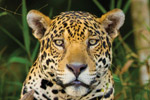 Catching a jaguar on a remote camera trap in the Amazon is a rare, happy sight. But catching a jaguar attempting to ambush a herd of peccaries is quite simply astonishing. “A research assistant, who was coding the videos sent me an email to have a look,” said primatologist, Mark Bowler, a postdoctoral fellow at […]
Catching a jaguar on a remote camera trap in the Amazon is a rare, happy sight. But catching a jaguar attempting to ambush a herd of peccaries is quite simply astonishing. “A research assistant, who was coding the videos sent me an email to have a look,” said primatologist, Mark Bowler, a postdoctoral fellow at […]
India’s tiger population up by more than 500 animals in four years

Judge protects Midwest wolves after 1,599 killed in three years
 Future wolf hunting and trapping seasons in the Upper Midwest are on hold after a judge ruled the Obama Administration erred in removing the top predator from the Endangered Species Act (ESA) last month. The ruling came nearly three years after the U.S.Fish and Wildlife Service dropped federal protections for the so-called Great Lakes’ wolf […]
Future wolf hunting and trapping seasons in the Upper Midwest are on hold after a judge ruled the Obama Administration erred in removing the top predator from the Endangered Species Act (ESA) last month. The ruling came nearly three years after the U.S.Fish and Wildlife Service dropped federal protections for the so-called Great Lakes’ wolf […]
Feds: gray wolf may have returned to the Grand Canyon after 70 years
 Obama administration proposes to remove wolves from the ESA even as the animals spread to new states A photo of what is believed to be a gray wolf sporting an inactive radio collar in forests just north of the Grand Canyon. Photo courtesy of the Arizona Game and Fish Department. For an update on this […]
Obama administration proposes to remove wolves from the ESA even as the animals spread to new states A photo of what is believed to be a gray wolf sporting an inactive radio collar in forests just north of the Grand Canyon. Photo courtesy of the Arizona Game and Fish Department. For an update on this […]
Russia and China blamed for blocking Antarctic marine reserve
.600.jpg) An Antarctic krill. Photo by: Uwe Kils/Creative Commons 3.0. Another year, another failed attempt to protect a significant chunk of the Ross Sea, which sits off the coast of Antarctica. According to observers, efforts to create the world’s biggest marine protected area to date were shot down by Russia and China during a meeting in […]
An Antarctic krill. Photo by: Uwe Kils/Creative Commons 3.0. Another year, another failed attempt to protect a significant chunk of the Ross Sea, which sits off the coast of Antarctica. According to observers, efforts to create the world’s biggest marine protected area to date were shot down by Russia and China during a meeting in […]
Photos: slumbering lions win top photo prize
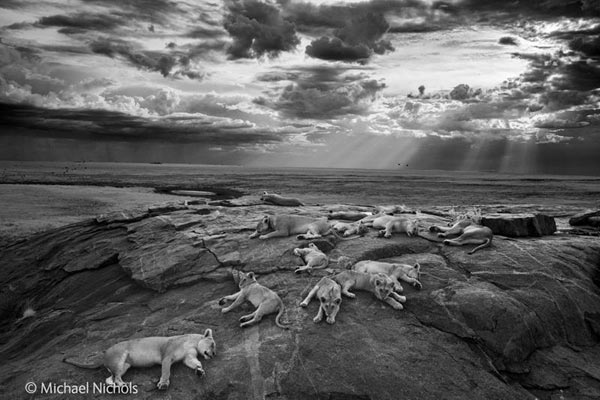 This photo of slumbering lions has won Michael ‘Nick’ Nichols the much-coveted Wildlife Photographer of the Year Title. Photo by: Michael ‘Nick’ Nichols / Wildlife Photographer of the Year 2014. The king of beasts took this year’s top prize in the Wildlife Photographer of the Year competition, which is co-owned by the Natural History Museum […]
This photo of slumbering lions has won Michael ‘Nick’ Nichols the much-coveted Wildlife Photographer of the Year Title. Photo by: Michael ‘Nick’ Nichols / Wildlife Photographer of the Year 2014. The king of beasts took this year’s top prize in the Wildlife Photographer of the Year competition, which is co-owned by the Natural History Museum […]
What makes the jaguar the ultimate survivor? New books highlights mega-predator’s remarkable past and precarious future
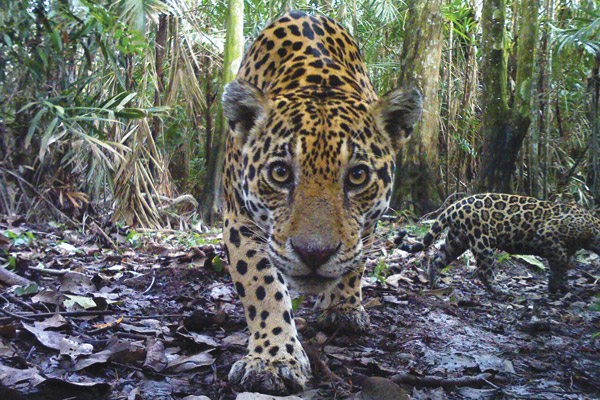 An interview with Alan Rabinowitz, author of the new book, An Indomitable Beast: the Journey of the Jaguar Female jaguar (staring into camera) with subadult male offspring moving through an old oil palm plantation in the jaguar corridor of Colombia. Photo by: Esteban Payan, Panthera. For thousands of years the jaguar was a God, then […]
An interview with Alan Rabinowitz, author of the new book, An Indomitable Beast: the Journey of the Jaguar Female jaguar (staring into camera) with subadult male offspring moving through an old oil palm plantation in the jaguar corridor of Colombia. Photo by: Esteban Payan, Panthera. For thousands of years the jaguar was a God, then […]
Stuff of fairy tales: stepping into Europe’s last old-growth forest
 On bison, wolves, and woodpeckers: the wonder of Europe’s only lowland virgin forest. Bialowieza Forest at dawn. Old-growth forest is characterized by ancient trees, tall canopies, little undergrowth, and a huge amount of dead wood. Photo by: Lukasz Mazurek/Wild Poland There is almost nothing left of Europe’s famed forests, those that provided for human communities […]
On bison, wolves, and woodpeckers: the wonder of Europe’s only lowland virgin forest. Bialowieza Forest at dawn. Old-growth forest is characterized by ancient trees, tall canopies, little undergrowth, and a huge amount of dead wood. Photo by: Lukasz Mazurek/Wild Poland There is almost nothing left of Europe’s famed forests, those that provided for human communities […]
Four donors pledge $80 million for big cats
 Four donors from around the world have pledged $80 million to cat conservation group, Panthera. The money will fund projects working to preserve tigers, lions, jaguars, cheetahs, leopards, snow leopards, and cougars over ten years. “Today marks a turning point for global cat conservation,” said Panthera Founder and Chairman of the Board, Thomas Kaplan, who […]
Four donors from around the world have pledged $80 million to cat conservation group, Panthera. The money will fund projects working to preserve tigers, lions, jaguars, cheetahs, leopards, snow leopards, and cougars over ten years. “Today marks a turning point for global cat conservation,” said Panthera Founder and Chairman of the Board, Thomas Kaplan, who […]
After 89-year absence a wolf returns to Iowa…and is shot dead
 DNA testing has confirmed that an animal shot in February in Iowa’s Buchanan County was in fact a wolf, according to the Iowa Department of Natural Resources. This is the first confirmed gray wolf (Canis lupus) in the U.S. state since 1925. Experts believe the wolf likely traveled south from Wisconsin or Minnesota, the latter […]
DNA testing has confirmed that an animal shot in February in Iowa’s Buchanan County was in fact a wolf, according to the Iowa Department of Natural Resources. This is the first confirmed gray wolf (Canis lupus) in the U.S. state since 1925. Experts believe the wolf likely traveled south from Wisconsin or Minnesota, the latter […]
Kala: the face of tigers in peril
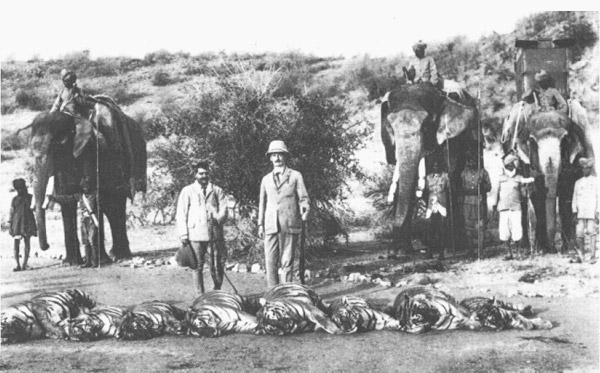 In 1864, Walter Campbell was an officer in the British Army, stationed in India when he penned these words in his journal: “Never attack a tiger on foot—if you can help it. There are cases in which you must do so. Then face him like a Briton, and kill him if you can; for if […]
In 1864, Walter Campbell was an officer in the British Army, stationed in India when he penned these words in his journal: “Never attack a tiger on foot—if you can help it. There are cases in which you must do so. Then face him like a Briton, and kill him if you can; for if […]
Predator appreciation: how saving lions, tigers, and polar bears could rescue ourselves
 Lioness feeding. Photo by: Cyril Christo and Marie Wilkinson. In the new book, In Predatory Light: Lions and Tigers and Polar Bears, authors Elizabeth Marshall Thomas, Sy Montgomery, and John Houston, and photographers Cyril Christo and Marie Wilkinson share with us an impassioned and detailed appeal to appreciate three of the world’s biggest predators: lions, […]
Lioness feeding. Photo by: Cyril Christo and Marie Wilkinson. In the new book, In Predatory Light: Lions and Tigers and Polar Bears, authors Elizabeth Marshall Thomas, Sy Montgomery, and John Houston, and photographers Cyril Christo and Marie Wilkinson share with us an impassioned and detailed appeal to appreciate three of the world’s biggest predators: lions, […]
Over 2,500 wolves killed in U.S.’s lower 48 since 2011
 Hunters and trappers have killed 2,567 gray wolves in the U.S.’s lower 48 states since 2011, according to recent data. Gray wolves (Canis lupus) were protected by the Endangered Species Act (ESA) for nearly 40 years before being stripped of their protection status by a legislative rider in 2011. Last year total wolf populations were […]
Hunters and trappers have killed 2,567 gray wolves in the U.S.’s lower 48 states since 2011, according to recent data. Gray wolves (Canis lupus) were protected by the Endangered Species Act (ESA) for nearly 40 years before being stripped of their protection status by a legislative rider in 2011. Last year total wolf populations were […]
Snow leopards and other mammals caught on camera trap in Uzbekistan (photos)
 Scientists knew that snow leopards (Panthera uncia) still survived in the Central Asian country of Uzbekistan, but late last year they captured the first ever photos. Camera traps in the Gissar Nature Reserve took photos of the big cats, along with bear, lynx, ibex, wild boar, and other mammals. The camera trap program was led […]
Scientists knew that snow leopards (Panthera uncia) still survived in the Central Asian country of Uzbekistan, but late last year they captured the first ever photos. Camera traps in the Gissar Nature Reserve took photos of the big cats, along with bear, lynx, ibex, wild boar, and other mammals. The camera trap program was led […]
Over 75 percent of large predators declining
 The world’s top carnivores are in big trouble: this is the take-away message from a new review paper published today in Science. Looking at 31 large-bodied carnivore species (i.e those over 15 kilograms or 33 pounds), the researchers found that 77 percent are in decline and more than half have seen their historical ranges decline […]
The world’s top carnivores are in big trouble: this is the take-away message from a new review paper published today in Science. Looking at 31 large-bodied carnivore species (i.e those over 15 kilograms or 33 pounds), the researchers found that 77 percent are in decline and more than half have seen their historical ranges decline […]
Samburu’s lions: how the big cats could make a comeback in Kenya
 Shivani Bhalla will be speaking at the Wildlife Conservation Network Expo in San Francisco on October 12th, 2013. In 2009 conservationists estimated that less than 2,000 lions survive in Kenya, a drop of 26 percent in just seven years. In addition, the East Africa country continues to hemorrhage lions: around a hundred a year. Poaching, […]
Shivani Bhalla will be speaking at the Wildlife Conservation Network Expo in San Francisco on October 12th, 2013. In 2009 conservationists estimated that less than 2,000 lions survive in Kenya, a drop of 26 percent in just seven years. In addition, the East Africa country continues to hemorrhage lions: around a hundred a year. Poaching, […]
Lions rising: community conservation making a difference for Africa’s kings in Mozambique
 Colleen Begg will be speaking at the Wildlife Conservation Network Expo in San Francisco on October 12th, 2013. Everyone knows that tigers, pandas, and blue whales are threatened with extinction—but lions!? Researchers were shocked to recently discover that lion populations have fallen precipitously: down to around 30,000 animals across the African continent. While 30,000 may […]
Colleen Begg will be speaking at the Wildlife Conservation Network Expo in San Francisco on October 12th, 2013. Everyone knows that tigers, pandas, and blue whales are threatened with extinction—but lions!? Researchers were shocked to recently discover that lion populations have fallen precipitously: down to around 30,000 animals across the African continent. While 30,000 may […]
Protecting predators in the wildest landscape you’ve never heard of
 A Ruaha male lion in his prime. Photo © : Sasja van Vechgel. The Serengeti, the Congo, the Okavango Delta: many of Africa’s great wildernesses are household names, however on a continent that never fails to surprise remain vast wild lands practically unknown to the global public. One of these is the Ruaha landscape: covering […]
A Ruaha male lion in his prime. Photo © : Sasja van Vechgel. The Serengeti, the Congo, the Okavango Delta: many of Africa’s great wildernesses are household names, however on a continent that never fails to surprise remain vast wild lands practically unknown to the global public. One of these is the Ruaha landscape: covering […]
Featured video: how tigers could save human civilization
 In the video below, John Vaillant, author of the The Tiger: A True Story of Vengeance and Survival, tells an audience at TEDxYYC about the similarities between tigers and human beings. Given these similarities—big mammals, apex predator, highly adaptable, intelligent, and stunningly “superior”—John Vaillant asks an illuminating question: what can we learn from the tiger? […]
In the video below, John Vaillant, author of the The Tiger: A True Story of Vengeance and Survival, tells an audience at TEDxYYC about the similarities between tigers and human beings. Given these similarities—big mammals, apex predator, highly adaptable, intelligent, and stunningly “superior”—John Vaillant asks an illuminating question: what can we learn from the tiger? […]
Nepal’s tigers on the rebound
 Nearly two hundred tigers roam the lowland forests of Nepal, according to a new survey. This is a 63 percent increase in the country’s tiger population since 2009, and rare good news for global efforts to save the tiger from extinction. The survey counted 198 Bengal tigers (Panthera tigris tigris) across five parks and three […]
Nearly two hundred tigers roam the lowland forests of Nepal, according to a new survey. This is a 63 percent increase in the country’s tiger population since 2009, and rare good news for global efforts to save the tiger from extinction. The survey counted 198 Bengal tigers (Panthera tigris tigris) across five parks and three […]
60 big cats killed in Brazilian parks in last two years
 At least 60 big cats have been killed within national protected areas in Brazil during the past two years according to a recent survey published in mongabay.com’s open access journal Tropical Conservation Science (TCS). The report, which focuses on jaguar (Panthera onca) and puma (Puma concolor) populations, within Brazilian protected areas shows that reserve management […]
At least 60 big cats have been killed within national protected areas in Brazil during the past two years according to a recent survey published in mongabay.com’s open access journal Tropical Conservation Science (TCS). The report, which focuses on jaguar (Panthera onca) and puma (Puma concolor) populations, within Brazilian protected areas shows that reserve management […]
Local people provide wildlife and forest data in park plagued by conflict
 There are often many obstacles for scientists when gauging wildlife decline and forest loss, and one of the most difficult is civil conflict, like the situation in the Similipal Tiger Reserve in India. But a new study in mongabay.com’s open access journal Tropical Conservation Science (TCS) finds that local communities may be used to gauge […]
There are often many obstacles for scientists when gauging wildlife decline and forest loss, and one of the most difficult is civil conflict, like the situation in the Similipal Tiger Reserve in India. But a new study in mongabay.com’s open access journal Tropical Conservation Science (TCS) finds that local communities may be used to gauge […]
Conserving top predators results in less CO2 in the air
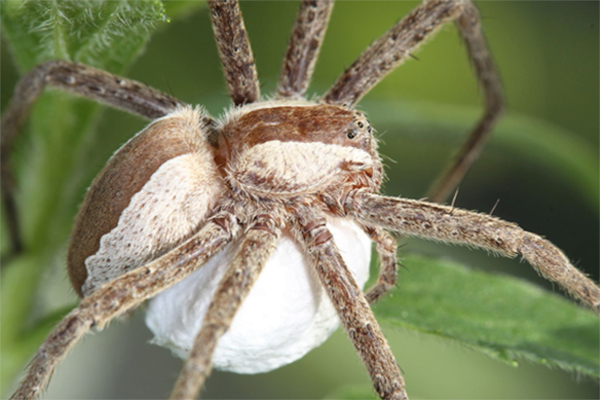 What does a wolf in Yellowstone National Park have in common with an ambush spider on a meadow in Connecticut? Both are predators and thus eat herbivores, such as elk (in the case of wolves) and grasshoppers (in the case of spiders). Elk and grasshoppers also have more in common than you probably imagine: they […]
What does a wolf in Yellowstone National Park have in common with an ambush spider on a meadow in Connecticut? Both are predators and thus eat herbivores, such as elk (in the case of wolves) and grasshoppers (in the case of spiders). Elk and grasshoppers also have more in common than you probably imagine: they […]
Tibetan monks partner with conservationists to protect the snow leopard
 The 2013 Zoos and Aquariums: Committing to Conservation (ZACC) conference runs from July 8th—July 12th in Des Moines, Iowa, hosted by the Blank Park Zoo. Ahead of the event, Mongabay.com is running a series of Q&As with presenters. For more interviews, please see our ZACC feed. Snow leopard. Photo by: Steve Winter/National Geographic. Tibetan monks […]
The 2013 Zoos and Aquariums: Committing to Conservation (ZACC) conference runs from July 8th—July 12th in Des Moines, Iowa, hosted by the Blank Park Zoo. Ahead of the event, Mongabay.com is running a series of Q&As with presenters. For more interviews, please see our ZACC feed. Snow leopard. Photo by: Steve Winter/National Geographic. Tibetan monks […]
Snowy tigers and giant owls: conservation against the odds in Russia’s Far East
-WCS-Russia.600.jpg) The 2013 Zoos and Aquariums: Committing to Conservation (ZACC) conference runs from July 8th – July 12th in Des Moines, Iowa, hosted by the Blank Park Zoo. Ahead of the event, Mongabay.com is running a series of Q&As with presenters. For more interviews, please see our ZACC feed. An Amur tiger in the Sikhote-Alin Mountains, […]
The 2013 Zoos and Aquariums: Committing to Conservation (ZACC) conference runs from July 8th – July 12th in Des Moines, Iowa, hosted by the Blank Park Zoo. Ahead of the event, Mongabay.com is running a series of Q&As with presenters. For more interviews, please see our ZACC feed. An Amur tiger in the Sikhote-Alin Mountains, […]
Scientists capture one of the world’s rarest big cats on film (photos)
 Less than a hundred kilometers from the bustling metropolis of Jakarta, scientists have captured incredible photos of one of the world’s most endangered big cats: the Javan leopard (Panthera pardus melas). Taken by a research project in Gunung Halimun-Salak National Park, the photos show the magnificent animal relaxing in dense primary rainforest. Scientists believe that […]
Less than a hundred kilometers from the bustling metropolis of Jakarta, scientists have captured incredible photos of one of the world’s most endangered big cats: the Javan leopard (Panthera pardus melas). Taken by a research project in Gunung Halimun-Salak National Park, the photos show the magnificent animal relaxing in dense primary rainforest. Scientists believe that […]
Could the Tasmanian tiger be hiding out in New Guinea?
 Many people still believe the Tasmanian tiger (Thylacinus cynocephalus) survives in the wilds of Tasmania, even though the species was declared extinct over eighty years ago. Sightings and reports of the elusive carnivorous marsupial, which was the top predator on the island, pop-up almost as frequently as those of Bigfoot in North America, but to […]
Many people still believe the Tasmanian tiger (Thylacinus cynocephalus) survives in the wilds of Tasmania, even though the species was declared extinct over eighty years ago. Sightings and reports of the elusive carnivorous marsupial, which was the top predator on the island, pop-up almost as frequently as those of Bigfoot in North America, but to […]
Crazy cat numbers: unusually high jaguar densities discovered in the Amazon rainforest
 Jaguars (Panthera onca) are the biggest cat in the Americas and the only member of the Panthera genus in the New World; an animal most people recognize, the jaguar is also the third largest cat in the world with an intoxicatingly dangerous beauty. The feline ranges from the harsh deserts of southern Arizona to the […]
Jaguars (Panthera onca) are the biggest cat in the Americas and the only member of the Panthera genus in the New World; an animal most people recognize, the jaguar is also the third largest cat in the world with an intoxicatingly dangerous beauty. The feline ranges from the harsh deserts of southern Arizona to the […]
Endangered primates and cats may be hiding out in swamps and mangrove forests
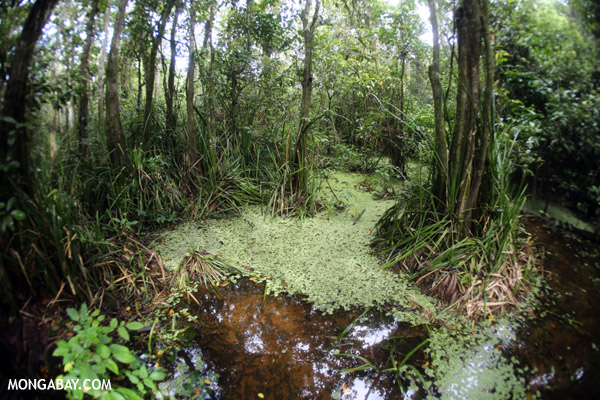 What happens to animals when their forest is cut down? If they can, they migrate to different forests. But in an age when forests are falling far and fast, many species may have to shift to entirely different environments. A new paper in Folia Primatologica theorizes that some 60 primate species and 20 wild cat […]
What happens to animals when their forest is cut down? If they can, they migrate to different forests. But in an age when forests are falling far and fast, many species may have to shift to entirely different environments. A new paper in Folia Primatologica theorizes that some 60 primate species and 20 wild cat […]
13 year search for Taiwan’s top predator comes up empty-handed
 After 13 years of searching for the Formosan clouded leopard (Neofelis nebulosa brachyura), once hopeful scientists say they believe the cat is likely extinct. For more than a decade scientists set up over 1,500 camera traps and scent traps in the mountains of Taiwan where they believed the cat may still be hiding out, only […]
After 13 years of searching for the Formosan clouded leopard (Neofelis nebulosa brachyura), once hopeful scientists say they believe the cat is likely extinct. For more than a decade scientists set up over 1,500 camera traps and scent traps in the mountains of Taiwan where they believed the cat may still be hiding out, only […]
Obama Administration to propose stripping protection from all gray wolves
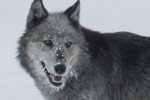 The U.S. Fish and Wildlife Service (USFWS) is proposing to end protection for all gray wolves (Canis lupus) in the lower 48 states, save for a small population of Mexican wolves in New Mexico, reports the Los Angeles Times. The proposal comes two years after wolves were removed from the Endangered Species Act (ESA) in […]
The U.S. Fish and Wildlife Service (USFWS) is proposing to end protection for all gray wolves (Canis lupus) in the lower 48 states, save for a small population of Mexican wolves in New Mexico, reports the Los Angeles Times. The proposal comes two years after wolves were removed from the Endangered Species Act (ESA) in […]
Lions for sale: big game hunting combines with lion bone trade to threaten endangered cats
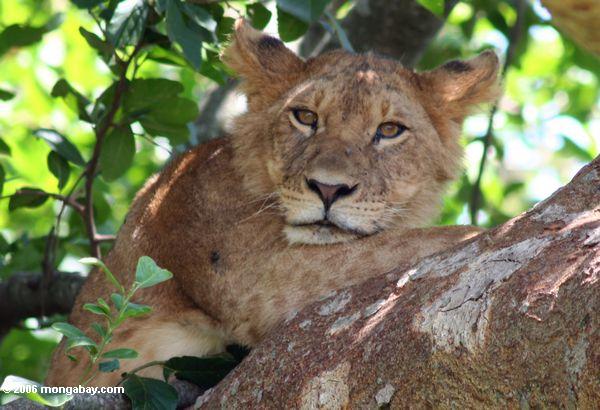 Koos Hermanus would rather not give names to the lions he breeds. So here, behind a 2.4-meter high electric fence, is 1R, a three-and-a-half-year-old male, who consumes 5kg of meat a day and weighs almost 200kg. It will only leave its enclosure once it has been “booked”‘ by a hunter, most of whom are from […]
Koos Hermanus would rather not give names to the lions he breeds. So here, behind a 2.4-meter high electric fence, is 1R, a three-and-a-half-year-old male, who consumes 5kg of meat a day and weighs almost 200kg. It will only leave its enclosure once it has been “booked”‘ by a hunter, most of whom are from […]
Amur leopard population rises to 50 animals, but at risk from tigers, poachers
 In the remote Russian far east, amid pine forests and long winters, a great cat may be beginning to make a recovery. A new survey estimates that the Amur leopard (Panthera pardus orientalis) population has risen to as many as 50 individuals. While this may not sound like much, it’s a far cry from a […]
In the remote Russian far east, amid pine forests and long winters, a great cat may be beginning to make a recovery. A new survey estimates that the Amur leopard (Panthera pardus orientalis) population has risen to as many as 50 individuals. While this may not sound like much, it’s a far cry from a […]
Male lions require dense vegetation for successful ambush hunting
 Female lion with wildebeest kill in Tanzania. Photo by: Rhett A. Butler. For a long time male lions were derided as the lazy ones in the pride, depending on females for the bulk of hunting and not pulling their weight. Much of this was based on field observations—female lions hunt cooperatively, often in open savannah, […]
Female lion with wildebeest kill in Tanzania. Photo by: Rhett A. Butler. For a long time male lions were derided as the lazy ones in the pride, depending on females for the bulk of hunting and not pulling their weight. Much of this was based on field observations—female lions hunt cooperatively, often in open savannah, […]
Forgotten lions: shedding light on the fate of lions in unprotected areas
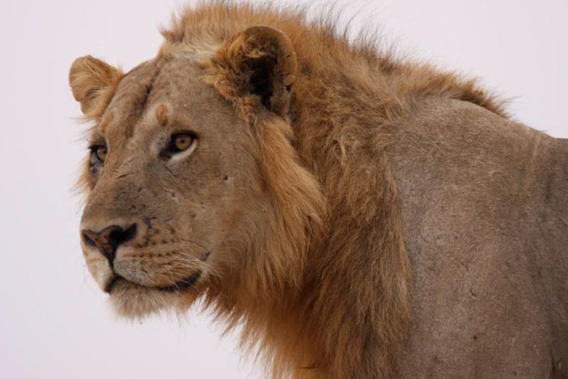 Male lion in Zambia. Photo by: Stuart Pimm. African lions (Panthera leo) living outside of protected areas like national parks or reserves also happen to be studied much less than those residing within protected areas, to the detriment of lion conservation initiatives. In response to this trend, a group of researchers surveyed an understudied, unprotected […]
Male lion in Zambia. Photo by: Stuart Pimm. African lions (Panthera leo) living outside of protected areas like national parks or reserves also happen to be studied much less than those residing within protected areas, to the detriment of lion conservation initiatives. In response to this trend, a group of researchers surveyed an understudied, unprotected […]
The end of wild Africa?: lions may need fences to survive
 Lions hang out by a fence in Tswalu Kalahari Reserve, South Africa. Photo by: Luke Hunter. In order for dwindling lion populations to survive in Africa, large-scale fencing projects may be required according to new research in Ecology Letters. Recent estimates have put lion populations down to 15,000-35,000, a massive drop from a population that […]
Lions hang out by a fence in Tswalu Kalahari Reserve, South Africa. Photo by: Luke Hunter. In order for dwindling lion populations to survive in Africa, large-scale fencing projects may be required according to new research in Ecology Letters. Recent estimates have put lion populations down to 15,000-35,000, a massive drop from a population that […]
Chinese government creating secret demand for tiger trade alleges NGO (warning: graphic images)
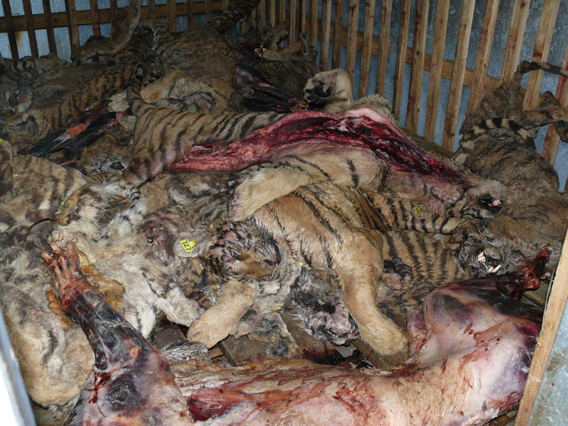 Tiger bodies in freezer in Guilin Tiger Bear Farm. Photo by: Belinda Wright/WPSI. The number of tigers being captive bred in China for consumption exceed those surviving in the wild—across 13 countries—by over a third, according to a new report by the Environmental Investigation Agency (EIA). The report, Hidden in Plain Sight, alleges that while […]
Tiger bodies in freezer in Guilin Tiger Bear Farm. Photo by: Belinda Wright/WPSI. The number of tigers being captive bred in China for consumption exceed those surviving in the wild—across 13 countries—by over a third, according to a new report by the Environmental Investigation Agency (EIA). The report, Hidden in Plain Sight, alleges that while […]
Jaguars, tapirs, oh my!: Amazon explorer films shocking wildlife bonanza in threatened forest
.360.jpg) Watching a new video by Amazon explorer, Paul Rosolie, one feels transported into a hidden world of stalking jaguars, heavyweight tapirs, and daylight-wandering giant armadillos. This is the Amazon as one imagines it as a child: still full of wild things. In just four weeks at a single colpa (or clay lick where mammals and […]
Watching a new video by Amazon explorer, Paul Rosolie, one feels transported into a hidden world of stalking jaguars, heavyweight tapirs, and daylight-wandering giant armadillos. This is the Amazon as one imagines it as a child: still full of wild things. In just four weeks at a single colpa (or clay lick where mammals and […]
Chasing down ‘quest species’: new book travels the world in search of rarity in nature
 A poster-child for rare species: the Javan rhino (Rhinoceros sondaicus) captured on camera trap in its last stand: Ujung Kulon National Park Java, Indonesia. Photo by: © Mike Griffiths / WWF-Canon. In his new book, The Kingdom of Rarities, Eric Dinerstein chases after rare animals around the world, from the maned wolf (Chrysocyon brachyurus) in […]
A poster-child for rare species: the Javan rhino (Rhinoceros sondaicus) captured on camera trap in its last stand: Ujung Kulon National Park Java, Indonesia. Photo by: © Mike Griffiths / WWF-Canon. In his new book, The Kingdom of Rarities, Eric Dinerstein chases after rare animals around the world, from the maned wolf (Chrysocyon brachyurus) in […]
Tigers gobble up 49 percent of India’s wildlife conservation funds, more imperiled species get nothing
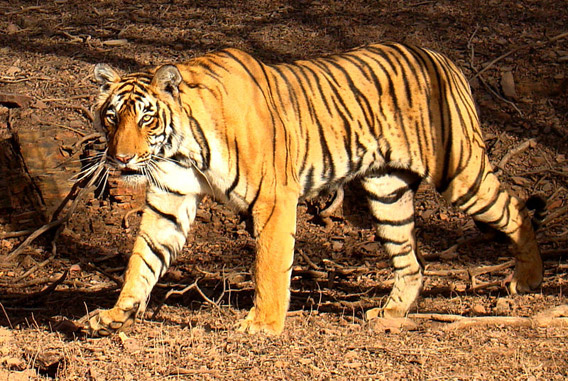 Bengal tiger in Rantgambhore National Park. Photo by: Bjørn Christian Tørrissen. Nearly half of India’s wildlife budget goes to one species: the tiger, reports a recent article in Live Mint. India has devoted around $63 million to wildlife conservation for 2013-2013, of which Project Tiger receives $31 million. The Bengal tiger (Panthera tigris tigris) is […]
Bengal tiger in Rantgambhore National Park. Photo by: Bjørn Christian Tørrissen. Nearly half of India’s wildlife budget goes to one species: the tiger, reports a recent article in Live Mint. India has devoted around $63 million to wildlife conservation for 2013-2013, of which Project Tiger receives $31 million. The Bengal tiger (Panthera tigris tigris) is […]
Animal picture of the day: the world’s biggest cat
 An eighteenth-month-old Amur tiger, named Botzman, was recently moved from a zoo in Moscow to Zoological Society of London (ZSL) Whipsnade Zoo. Photo courtesy of ZSL Whipsnade Zoo. The Amur tiger (Panthera tigris altaica), also known as the Siberian tiger, is the world’s biggest cat. An adult male weighs on average about 390 pounds (176 […]
An eighteenth-month-old Amur tiger, named Botzman, was recently moved from a zoo in Moscow to Zoological Society of London (ZSL) Whipsnade Zoo. Photo courtesy of ZSL Whipsnade Zoo. The Amur tiger (Panthera tigris altaica), also known as the Siberian tiger, is the world’s biggest cat. An adult male weighs on average about 390 pounds (176 […]
Over 1,500 wolves killed in the contiguous U.S. since hunting legalized
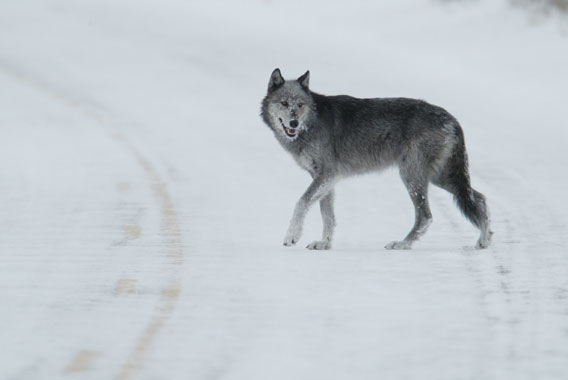 Wolf in Yellowstone National Park. Photo courtesy of Yellowstone National Park. Hunters and trappers have killed approximately 1,530 wolves over the last 18 months in the contiguous U.S., which excludes Alaska. After being protected under the Endangered Species Act (ESA) for 38 years, gray wolves (Canis lupus) were stripped of their protected states in 2011 […]
Wolf in Yellowstone National Park. Photo courtesy of Yellowstone National Park. Hunters and trappers have killed approximately 1,530 wolves over the last 18 months in the contiguous U.S., which excludes Alaska. After being protected under the Endangered Species Act (ESA) for 38 years, gray wolves (Canis lupus) were stripped of their protected states in 2011 […]
Geneticists discover distinct lion group in squalid conditions
 Behind bars and waiting for science: the power of genetic testing for the Addis Fifteen. Male and female Addis lions in the Addis Ababa Lion Zoo. Photo courtesy of: Klaus Eulenberger. They languished behind bars in squalid conditions, their very survival in jeopardy. Outside, an international team of advocates strove to bring worldwide attention to […]
Behind bars and waiting for science: the power of genetic testing for the Addis Fifteen. Male and female Addis lions in the Addis Ababa Lion Zoo. Photo courtesy of: Klaus Eulenberger. They languished behind bars in squalid conditions, their very survival in jeopardy. Outside, an international team of advocates strove to bring worldwide attention to […]
Claim of human and tiger ‘coexistence’ lacks perspective
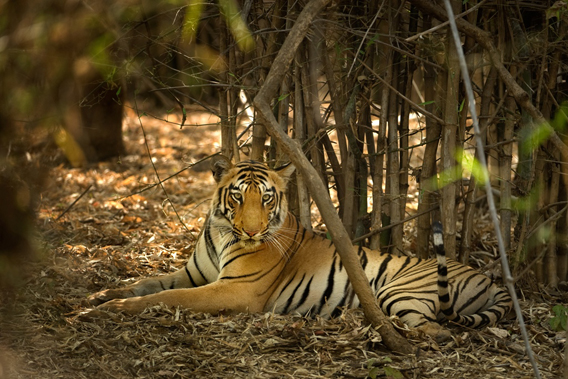 The tiger is a globally endangered top predator occupying only 7% of its historic range and only 3000-3500 individuals are believed to be left in wild. Picture © Kalyan Varma. Nepal’s Chitwan National Park was the site of a study, published in September 2012 by Carter and others, which concluded that, tigers coexist with humans […]
The tiger is a globally endangered top predator occupying only 7% of its historic range and only 3000-3500 individuals are believed to be left in wild. Picture © Kalyan Varma. Nepal’s Chitwan National Park was the site of a study, published in September 2012 by Carter and others, which concluded that, tigers coexist with humans […]
Living beside a tiger reserve: scientists study compensation for human-wildlife conflict in India
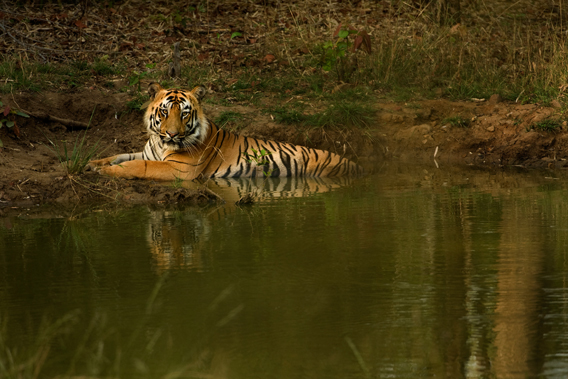 Bengal tiger in Kanha Tiger Reserve. Photo by: Kalyan Varma. During an average year, 87% of households surrounding Kanha Tiger Reserve in Central India report experiencing some kind of conflict with wild animals, according to a new paper in the open-access journal PLOS One. Co-existence with protected, free-roaming wildlife can be a challenge when living […]
Bengal tiger in Kanha Tiger Reserve. Photo by: Kalyan Varma. During an average year, 87% of households surrounding Kanha Tiger Reserve in Central India report experiencing some kind of conflict with wild animals, according to a new paper in the open-access journal PLOS One. Co-existence with protected, free-roaming wildlife can be a challenge when living […]
Three developing nations move to ban hunting to protect vanishing wildlife
 African savannah elephants on the Chobe River in Botswana. From 2014 on, hunting will no longer be allowed in Botswana’s public lands. Photo by: Tiffany Roufs. Three developing countries have recently toughened hunting regulations believing the changes will better protect vanishing species. Botswana has announced it will ban trophy hunting on public lands beginning in […]
African savannah elephants on the Chobe River in Botswana. From 2014 on, hunting will no longer be allowed in Botswana’s public lands. Photo by: Tiffany Roufs. Three developing countries have recently toughened hunting regulations believing the changes will better protect vanishing species. Botswana has announced it will ban trophy hunting on public lands beginning in […]
An avalanche of decline: snow leopard populations are plummeting
 Snow leopard in the Toronto Zoo. Photo by: John Vetterli. The trading of big cat pelts is nothing new, but recent demand for snow leopard pelts and taxidermy mounts has added a new commodity to the illegal trade in wildlife products, according to the Environmental Investigation Agency (EIA). Traditionally, the market for large cat products […]
Snow leopard in the Toronto Zoo. Photo by: John Vetterli. The trading of big cat pelts is nothing new, but recent demand for snow leopard pelts and taxidermy mounts has added a new commodity to the illegal trade in wildlife products, according to the Environmental Investigation Agency (EIA). Traditionally, the market for large cat products […]
Lion population falls 68 percent in 50 years
 Female lion with wildebeest kill in Tanzania. Photo by: Rhett A. Butler. African lions, one of the most iconic species on the planet, are in rapid decline. According to a new study in Biodiversity Conservation, the African lion (Panthera leo leo) population has dropped from around 100,000 animals just fifty years ago to as few […]
Female lion with wildebeest kill in Tanzania. Photo by: Rhett A. Butler. African lions, one of the most iconic species on the planet, are in rapid decline. According to a new study in Biodiversity Conservation, the African lion (Panthera leo leo) population has dropped from around 100,000 animals just fifty years ago to as few […]
Africa’s great savannahs may be more endangered than the world’s rainforests
 Grasslands in Kenya’s Masai Mara. Photo by: Rhett A. Butler. Few of the world’s ecosystems are more iconic than Africa’s sprawling savannahs home to elephants, giraffes, rhinos, and the undisputed king of the animal kingdom: lions. This wild realm, where megafauna still roam in abundance, has inspired everyone from Ernest Hemingway to Karen Blixen, and […]
Grasslands in Kenya’s Masai Mara. Photo by: Rhett A. Butler. Few of the world’s ecosystems are more iconic than Africa’s sprawling savannahs home to elephants, giraffes, rhinos, and the undisputed king of the animal kingdom: lions. This wild realm, where megafauna still roam in abundance, has inspired everyone from Ernest Hemingway to Karen Blixen, and […]
Wolves, mole rats, and nyala: the struggle to conserve Ethiopia’s highlands
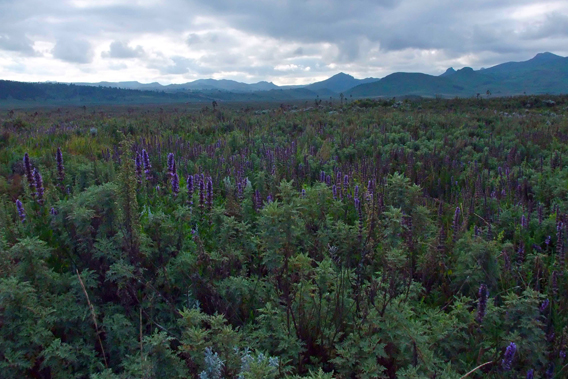 Gaysay Grasslands in Bale Mountains National Park. Photo courtesy of the Frankfurt Zoological Society (FZS). There is a place in the world where wolves live almost entirely off mountain rodents, lions dwell in forests, and freshwater rolls downstream to 12 million people, but the place—Ethiopia’s Bale Mountains National Park—remains imperiled by a lack of legal […]
Gaysay Grasslands in Bale Mountains National Park. Photo courtesy of the Frankfurt Zoological Society (FZS). There is a place in the world where wolves live almost entirely off mountain rodents, lions dwell in forests, and freshwater rolls downstream to 12 million people, but the place—Ethiopia’s Bale Mountains National Park—remains imperiled by a lack of legal […]
Controversial wolf hunt moves to the Midwest, 196 wolves killed to date
 Many top predators worldwide remain hated and feared. Photo courtesy of the National Park Service. The hugely controversial wolf hunt in the U.S. has spread from the western U.S. (Montana, Idaho, and Wyoming) to the Midwest (Minnesota and Wisconsin) this year. Although the wolf hunt is less than a month old in the region—and only […]
Many top predators worldwide remain hated and feared. Photo courtesy of the National Park Service. The hugely controversial wolf hunt in the U.S. has spread from the western U.S. (Montana, Idaho, and Wyoming) to the Midwest (Minnesota and Wisconsin) this year. Although the wolf hunt is less than a month old in the region—and only […]
Illegal hunting threatens iconic animals across Africa’s great savannas, especially predators
 Lion with a snare around its neck. Photo by: Frederike Otten. Courtesy of Panthera. Bushmeat hunting has become a grave concern for species in West and Central Africa, but a new report notes that lesser-known illegal hunting in Africa’s iconic savannas is also decimating some animals. Surprisingly, illegal hunting across eastern and southern Africa is […]
Lion with a snare around its neck. Photo by: Frederike Otten. Courtesy of Panthera. Bushmeat hunting has become a grave concern for species in West and Central Africa, but a new report notes that lesser-known illegal hunting in Africa’s iconic savannas is also decimating some animals. Surprisingly, illegal hunting across eastern and southern Africa is […]
Picture of the day: the maned lioness
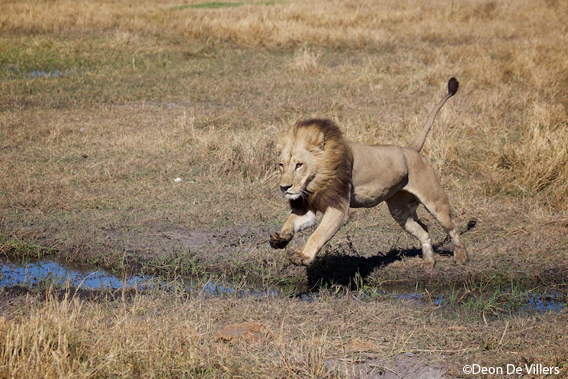 A maned lioness in Botswanna’s Okavango Delta. Photo by: Deon de Villers. The title is not a typo. Sometimes lioness grow manes as rich and large as males, and there appears to be larger proportion of such ‘maned lionesses’ in Botswana’s Okavango Delta. Luke Hunter, head of the cat NGO Panthera, told National Geographic News […]
A maned lioness in Botswanna’s Okavango Delta. Photo by: Deon de Villers. The title is not a typo. Sometimes lioness grow manes as rich and large as males, and there appears to be larger proportion of such ‘maned lionesses’ in Botswana’s Okavango Delta. Luke Hunter, head of the cat NGO Panthera, told National Geographic News […]
Jaguar conservation gets a boost in North and Central America
 First camera trap photo of a jaguar taken by Panthera in a deforested area of Costa Rica’s Barbilla-Destierro SubCorridor. Photo by: Panthera. Jaguar conservation has received a huge boost in the past few months both in Latin America and in the U.S. An historic agreement singed between the world’s leading wild cat conservation organization Panthera […]
First camera trap photo of a jaguar taken by Panthera in a deforested area of Costa Rica’s Barbilla-Destierro SubCorridor. Photo by: Panthera. Jaguar conservation has received a huge boost in the past few months both in Latin America and in the U.S. An historic agreement singed between the world’s leading wild cat conservation organization Panthera […]
Cute animal picture of the day: tiger triplets
 The Siberian tiger triplets were born to parents, Katharina and Sasha. Photo by: Julie Larsen Maher/WCS. Last month, the Wildlife Conservation Society’s (WCS) Bronx Zoo saw the arrival of three Siberian tiger cubs (Panthera tigris altaica). Also known as Amur tigers, they are the world’s largest cats with adult males weighing up to 318 kilograms […]
The Siberian tiger triplets were born to parents, Katharina and Sasha. Photo by: Julie Larsen Maher/WCS. Last month, the Wildlife Conservation Society’s (WCS) Bronx Zoo saw the arrival of three Siberian tiger cubs (Panthera tigris altaica). Also known as Amur tigers, they are the world’s largest cats with adult males weighing up to 318 kilograms […]
Buffer zones key to survival of maned wolf
 Maned wolf at Beardsley Zoo. Photo by: Sage Ross. Known for its abnormally long lanky legs, its reddish-orange coat, and its omnivorous diet, the maned wolf (Chrysocyon brachyurus) is one of the more beautiful and bizarre predators of South America. However its stronghold, the Brazilian Cerrado, is vanishing rapidly to industrialized agriculture and urban development. […]
Maned wolf at Beardsley Zoo. Photo by: Sage Ross. Known for its abnormally long lanky legs, its reddish-orange coat, and its omnivorous diet, the maned wolf (Chrysocyon brachyurus) is one of the more beautiful and bizarre predators of South America. However its stronghold, the Brazilian Cerrado, is vanishing rapidly to industrialized agriculture and urban development. […]
Tiger and cubs filmed near proposed dam in Thailand
A tigress and two cubs have been filmed by remote camera trap in a forest under threat by a $400 million dam in Thailand. To be built on the Mae Wong River, the dam imperils two Thai protected areas, Mae Wong National Park and Huay Kha Khaeng Wildlife Sanctuary, according to the World Wide Fund […]
King of the jungle: lions discovered in rainforests
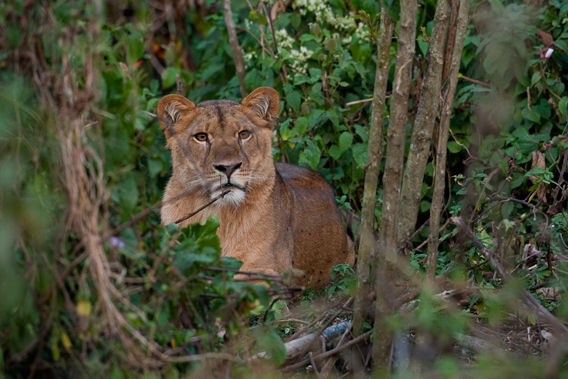 Female lion peers through the thick foliage of a montane rainforest in Ethiopia. Photo by: Bruno D’Amicis/NABU. Calling the African lion (Panthera leo) the ‘king of the jungle’ is usually a misnomer, as the species is almost always found in savannah or dry forests, but recent photos by the Germany-based Nature and Biodiversity Conservation Union […]
Female lion peers through the thick foliage of a montane rainforest in Ethiopia. Photo by: Bruno D’Amicis/NABU. Calling the African lion (Panthera leo) the ‘king of the jungle’ is usually a misnomer, as the species is almost always found in savannah or dry forests, but recent photos by the Germany-based Nature and Biodiversity Conservation Union […]
First snow leopards collared in Afghanistan as species faces rising threat from climate change
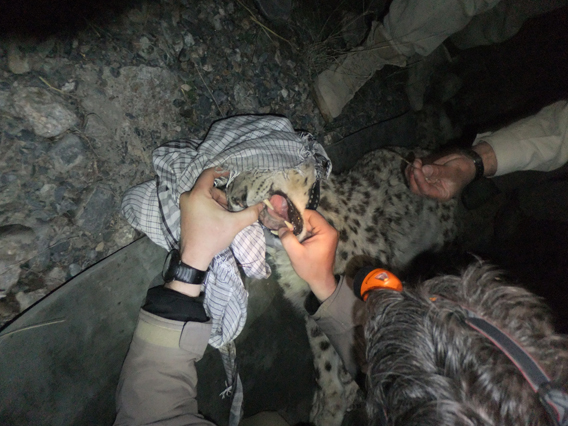 The research team conducts a dental exam of a snow leopard prior to its release. Photo by: Anthony Simms/WCS. Scientists have captured and collared two snow leopards (Panthera uncia), arguably one of the world’s most elusive predators, in Afghanistan for the first time. Undertaken by researchers with Wildlife Conservation Society (WCS) and Afghani vets, the […]
The research team conducts a dental exam of a snow leopard prior to its release. Photo by: Anthony Simms/WCS. Scientists have captured and collared two snow leopards (Panthera uncia), arguably one of the world’s most elusive predators, in Afghanistan for the first time. Undertaken by researchers with Wildlife Conservation Society (WCS) and Afghani vets, the […]
Nearly 50 tigers die in India in last six months
 Bengal tiger in Rantgambhore National Park. Photo by: Bjørn Christian Tørrissen. Since January 1st, 48 Bengal tigers (Panthera tigris tigris) have been found dead in India, which has the world’s largest population of tigers. According to India’s National Tiger Conservation Authority (NTCA), 19 of those deaths have been confirmed to be at the hands of […]
Bengal tiger in Rantgambhore National Park. Photo by: Bjørn Christian Tørrissen. Since January 1st, 48 Bengal tigers (Panthera tigris tigris) have been found dead in India, which has the world’s largest population of tigers. According to India’s National Tiger Conservation Authority (NTCA), 19 of those deaths have been confirmed to be at the hands of […]
New campaign targets snares in effort to save world’s big cats
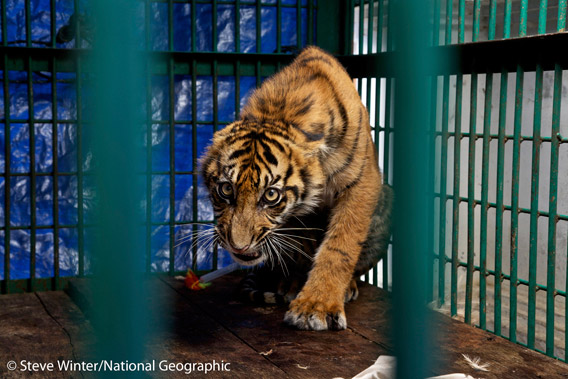 This six-month old Sumatran tiger cub was strung up in a snare for three days before it was rescued. However, it’s paw had to be amputated. While the cub survived, its freedom has been lost. Unable to hunt and fend for itself, the cub now lives in captivity on the Indonesian island of Java. Photo […]
This six-month old Sumatran tiger cub was strung up in a snare for three days before it was rescued. However, it’s paw had to be amputated. While the cub survived, its freedom has been lost. Unable to hunt and fend for itself, the cub now lives in captivity on the Indonesian island of Java. Photo […]
Over half of world’s tiger reserves lack minimum protection
 A year-and-a-half after a landmark summit that pledged to double the world’s number of tigers by 2022, and still 65 percent of tiger reserves lack minimum standards of protection for the world’s largest cat, according to the World Wide Fund for Nature (WWF). Reporting at the first meeting of all 13 tiger-range countries since the […]
A year-and-a-half after a landmark summit that pledged to double the world’s number of tigers by 2022, and still 65 percent of tiger reserves lack minimum standards of protection for the world’s largest cat, according to the World Wide Fund for Nature (WWF). Reporting at the first meeting of all 13 tiger-range countries since the […]
Javan officials employ camera traps to find extinct tiger
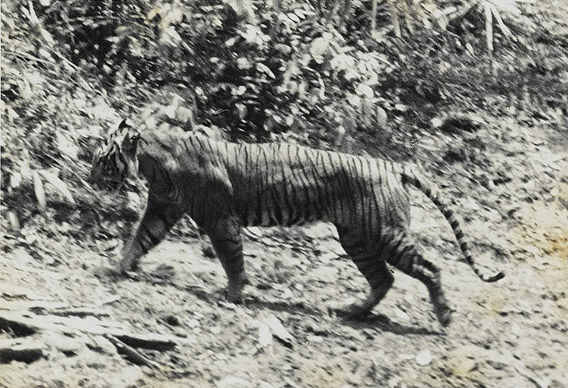 A Javan tiger in 1938 at Ujung Kulon. Photo by: Andries Hoogerwerf. Although officially declared extinct in 2003, some people believe the Javan tiger (panthera tigris sondaica) is still alive in the island’s Meru Betiri National Park. To prove the big cat has not vanished for good, wildlife officials have installed five camera traps in […]
A Javan tiger in 1938 at Ujung Kulon. Photo by: Andries Hoogerwerf. Although officially declared extinct in 2003, some people believe the Javan tiger (panthera tigris sondaica) is still alive in the island’s Meru Betiri National Park. To prove the big cat has not vanished for good, wildlife officials have installed five camera traps in […]
Investigation links APP to illegal logging of protected trees
 Sumatra rainforest canopy seen from the base of a compass tree . Photo by: Rhett A. Butler. UPDATE: Greenpeace has stated that it has handed over evidence of illegal logging by APP suppliers to Indonesian police; an investigation looks likely. A year-long undercover investigation has found evidence of Asia Pulp and Paper (APP) companies cutting […]
Sumatra rainforest canopy seen from the base of a compass tree . Photo by: Rhett A. Butler. UPDATE: Greenpeace has stated that it has handed over evidence of illegal logging by APP suppliers to Indonesian police; an investigation looks likely. A year-long undercover investigation has found evidence of Asia Pulp and Paper (APP) companies cutting […]
Over 450 wolves shot dead in Idaho, Montana to date
 Wolf in Yellowstone National Park. Photo courtesy of Yellowstone National Park. Less than a year after being pulled off the Endangered Species Act (ESA), gray wolves (Canis lupus) in the western U.S. are facing an onslaught of hunting. The hunting season for wolves has just closed in Montana with 160 individuals killed, around 75 percent […]
Wolf in Yellowstone National Park. Photo courtesy of Yellowstone National Park. Less than a year after being pulled off the Endangered Species Act (ESA), gray wolves (Canis lupus) in the western U.S. are facing an onslaught of hunting. The hunting season for wolves has just closed in Montana with 160 individuals killed, around 75 percent […]
When giant coyotes roamed the Earth
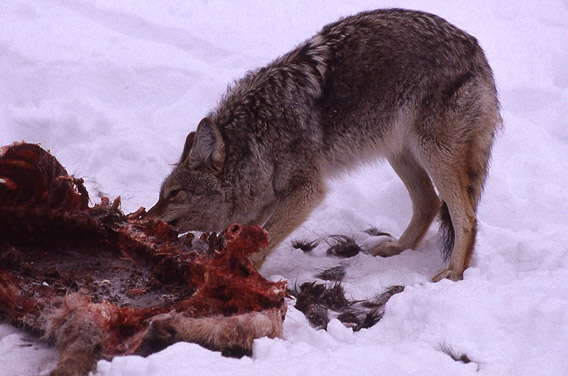 Coyote feeding on elk carcass in Yellowstone National Park. Photo by: Jim Peaco/U.S. National Park Service. Not long ago, geologically speaking, coyotes (Canis latrans) were bigger and more robust than today’s animals. In the late Pleistocene, over 10,000 years ago, coyotes rivaled grey wolves (Canis lupus) in size. But, according to a new paper in […]
Coyote feeding on elk carcass in Yellowstone National Park. Photo by: Jim Peaco/U.S. National Park Service. Not long ago, geologically speaking, coyotes (Canis latrans) were bigger and more robust than today’s animals. In the late Pleistocene, over 10,000 years ago, coyotes rivaled grey wolves (Canis lupus) in size. But, according to a new paper in […]
The camera trap revolution: how a simple device is shaping research and conservation worldwide
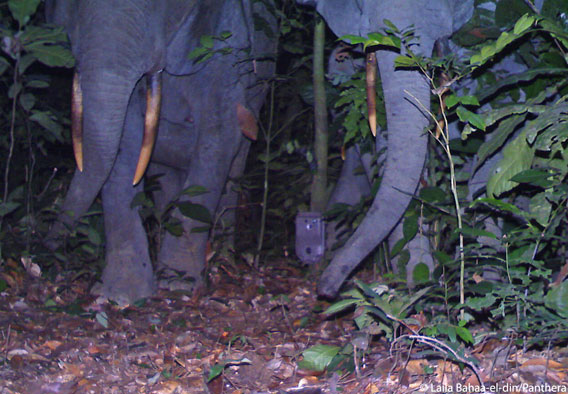 This article is available for a limited time on mongabay.com. It has also been published in a book by mongabay journalist, Jeremy Hance: Life is Good: Conservation in an Age of Mass Extinction. The book is also available in Europe. This is an expanded version of an article that ran on Yale e360 on December […]
This article is available for a limited time on mongabay.com. It has also been published in a book by mongabay journalist, Jeremy Hance: Life is Good: Conservation in an Age of Mass Extinction. The book is also available in Europe. This is an expanded version of an article that ran on Yale e360 on December […]
Invasion!: Burmese pythons decimate mammals in the Everglades
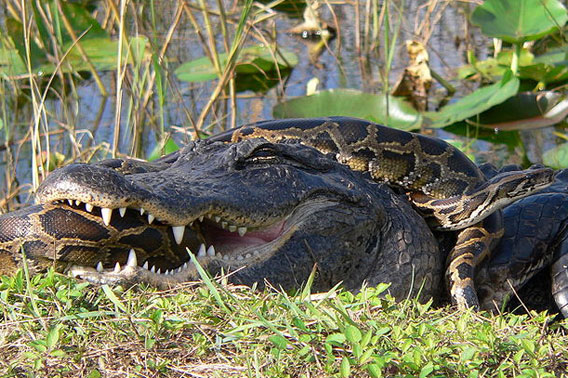 An American alligator and a Burmese python struggle in Everglades National Park. Photo by: Lori Oberhofer, U.S. National Park Service. The Everglades in southern Florida has faced myriad environmental impacts from draining for sprawl to the construction of canals, but even as the U.S. government moves slowly on an ambitious plan to restore the massive […]
An American alligator and a Burmese python struggle in Everglades National Park. Photo by: Lori Oberhofer, U.S. National Park Service. The Everglades in southern Florida has faced myriad environmental impacts from draining for sprawl to the construction of canals, but even as the U.S. government moves slowly on an ambitious plan to restore the massive […]
World’s most expensive tuna
 A 593 pound Pacific bluefin tuna sold for $735,000 (56.49 million yen) in Tokyo’s Tsukiji market today. This beats the previous record price hit last year by over $260,000. Why so expensive? Bluefin tuna, considered the best sashimi and sushi in the world, have been fished to near extinction with the population of the Pacific […]
A 593 pound Pacific bluefin tuna sold for $735,000 (56.49 million yen) in Tokyo’s Tsukiji market today. This beats the previous record price hit last year by over $260,000. Why so expensive? Bluefin tuna, considered the best sashimi and sushi in the world, have been fished to near extinction with the population of the Pacific […]
First ever survey shows Sumatran tiger hanging on as forests continue to vanish
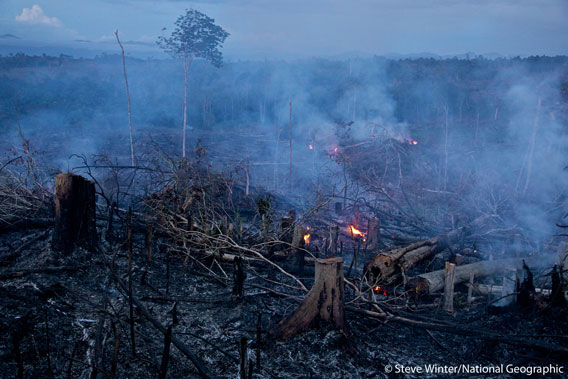 Scorched rainforest in Sumatra. Photo by: Steve Winter/National Geographic. The first-ever Sumatran-wide survey of the island’s top predator, the Sumatran tiger (Panthera tigris sumatrae), proves that the great cat is holding on even as forests continue to vanish. The study, carried out by eight NGOs and the Indonesian government, shows that the tiger is still […]
Scorched rainforest in Sumatra. Photo by: Steve Winter/National Geographic. The first-ever Sumatran-wide survey of the island’s top predator, the Sumatran tiger (Panthera tigris sumatrae), proves that the great cat is holding on even as forests continue to vanish. The study, carried out by eight NGOs and the Indonesian government, shows that the tiger is still […]
Penurunan predator puncak dan megafauna ‘pengaruh manusia yang paling mudah menyebar pada alam ‘
 Singa betina mempertahankan wildebeest yang terbunuh di Tanzania. Foto oleh: Rhett A. Butler. Populasi serigala di seluruh dunia telah turun sekitar 99 persen dari jumlah populasi yang pernah ada dalam sejarah. Populasi singa jatuh dari 450.000 menjadi 20.000 dalam 50 tahun. Tiga subspesies harimau punah di abad ke-20. Penangkapan ikan yang berlebihan dan pemotongan sirip […]
Singa betina mempertahankan wildebeest yang terbunuh di Tanzania. Foto oleh: Rhett A. Butler. Populasi serigala di seluruh dunia telah turun sekitar 99 persen dari jumlah populasi yang pernah ada dalam sejarah. Populasi singa jatuh dari 450.000 menjadi 20.000 dalam 50 tahun. Tiga subspesies harimau punah di abad ke-20. Penangkapan ikan yang berlebihan dan pemotongan sirip […]
Scientists confirm ancient Egyptian knowledge: Nile crocodile is two species
 Nile crocodile in Madagascar. Photo by: Rhett A. Butler. DNA has shown that the Nile crocodile is in fact two very different species: a bigger, more aggressive crocodile and a smaller, tamer species that today survives only in West Africa. While the taxonomy of the Nile crocodile has been controversial for over a century, the […]
Nile crocodile in Madagascar. Photo by: Rhett A. Butler. DNA has shown that the Nile crocodile is in fact two very different species: a bigger, more aggressive crocodile and a smaller, tamer species that today survives only in West Africa. While the taxonomy of the Nile crocodile has been controversial for over a century, the […]
The heroic wolf: are wolves the key to saving the Canada lynx?
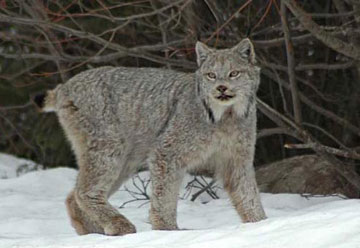 In 2000 the Canada lynx (Lynx canadensis) was listed as threatened under the US Endangered Species Act (ESA). While remaining stable in Canada and Alaska, the Canada lynx population had essentially collapsed in much of the continental US, excluding Alaska. Aside from habitat loss, one of the main factors imperiling the medium-sized wild cat was […]
In 2000 the Canada lynx (Lynx canadensis) was listed as threatened under the US Endangered Species Act (ESA). While remaining stable in Canada and Alaska, the Canada lynx population had essentially collapsed in much of the continental US, excluding Alaska. Aside from habitat loss, one of the main factors imperiling the medium-sized wild cat was […]
Leopards losing out to bushmeat hunters in competition for prey
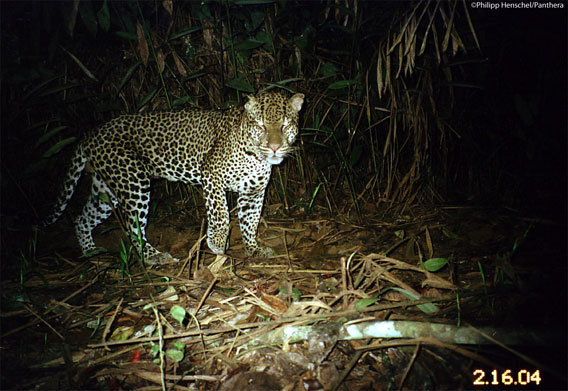 WARNING: Graphic photos after the article. Leopard caught on camera trap in Gabon. Photo by: Philipp Henschel/Panthera. According to a surprising new study in the Journal of Zoology, bushmeat hunting is imperiling jungle-dwelling leopards (Panthera pardus) in Africa, even though hunters aren’t targeting the elusive big cats themselves. Instead, by hunting many of the leopard’s […]
WARNING: Graphic photos after the article. Leopard caught on camera trap in Gabon. Photo by: Philipp Henschel/Panthera. According to a surprising new study in the Journal of Zoology, bushmeat hunting is imperiling jungle-dwelling leopards (Panthera pardus) in Africa, even though hunters aren’t targeting the elusive big cats themselves. Instead, by hunting many of the leopard’s […]
Cameratraps take global snapshot of declining tropical mammals
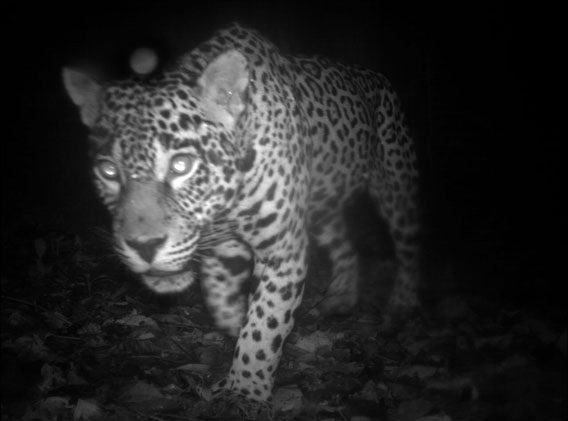 Central Suriname Nature Reserve, Suriname. A jaguar (Panthera Onca), a Near Threatened species. Of the sites researched, Suriname’s site presented the highest number of species diversity. Photo courtesy of Conservation International Suriname, a member of the TEAM network. A groundbreaking cameratrap study has mapped the abundance, or lack thereof, of tropical mammal populations across seven […]
Central Suriname Nature Reserve, Suriname. A jaguar (Panthera Onca), a Near Threatened species. Of the sites researched, Suriname’s site presented the highest number of species diversity. Photo courtesy of Conservation International Suriname, a member of the TEAM network. A groundbreaking cameratrap study has mapped the abundance, or lack thereof, of tropical mammal populations across seven […]
China opens trade in ‘legal’ tiger skins
 Wild cat furs on sale in market in China, 2006. Photo by: Rhett A. Butler. The Environmental Investigation Agency (EIA) has warned the US, the UK, and all tiger-range nations that China has re-opened the trade in wild cat skins—including tigers—ahead of a Convention on International Trade in Endangered Species (CITES) meeting this week in […]
Wild cat furs on sale in market in China, 2006. Photo by: Rhett A. Butler. The Environmental Investigation Agency (EIA) has warned the US, the UK, and all tiger-range nations that China has re-opened the trade in wild cat skins—including tigers—ahead of a Convention on International Trade in Endangered Species (CITES) meeting this week in […]
Decline in top predators and megafauna ‘humankind’s most pervasive influence on nature’
 Lioness defends wildebeest kill in Tanzania. Photo by: Rhett A. Butler. Worldwide wolf populations have dropped around 99 percent from historic populations. Lion populations have fallen from 450,000 to 20,000 in 50 years. Three subspecies of tiger went extinct in the 20th Century. Overfishing and finning has cut some shark populations down by 90 percent […]
Lioness defends wildebeest kill in Tanzania. Photo by: Rhett A. Butler. Worldwide wolf populations have dropped around 99 percent from historic populations. Lion populations have fallen from 450,000 to 20,000 in 50 years. Three subspecies of tiger went extinct in the 20th Century. Overfishing and finning has cut some shark populations down by 90 percent […]
Viable population of snow leopards still roam Afghanistan (pictures)
.568.jpg) Snow leopard in the Wakhan Corridor caught on camera trap. Photo by: Wildlife Conservation Society. Decades of war and poverty has not exterminated snow leopards (Panthera uncia) in Afghanistan according to a new paper in the International Journal of Environmental Studies, written by researchers with the Wildlife Conservation Society (WCS). Instead the researchers report a […]
Snow leopard in the Wakhan Corridor caught on camera trap. Photo by: Wildlife Conservation Society. Decades of war and poverty has not exterminated snow leopards (Panthera uncia) in Afghanistan according to a new paper in the International Journal of Environmental Studies, written by researchers with the Wildlife Conservation Society (WCS). Instead the researchers report a […]
The truth about polar bears and climate change
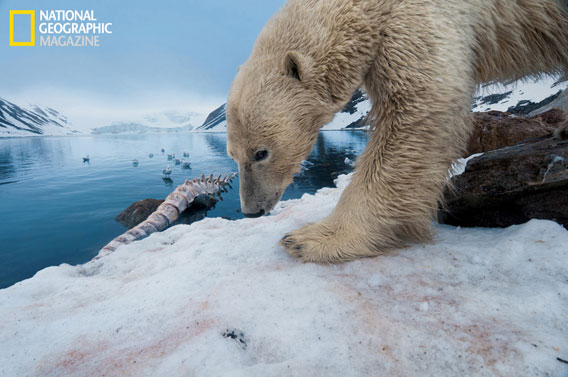 Polar bear beside a whale carcass. Taken with a remote camera. © National Geographic Entertainment. Photo by: Florian Schulz. Although scientists say innumerable species are threatened by climate change, polar bears have been the global symbol of the movement to rein-in greenhouse gas emissions. This is perhaps not surprising, since polar bears are well known […]
Polar bear beside a whale carcass. Taken with a remote camera. © National Geographic Entertainment. Photo by: Florian Schulz. Although scientists say innumerable species are threatened by climate change, polar bears have been the global symbol of the movement to rein-in greenhouse gas emissions. This is perhaps not surprising, since polar bears are well known […]
Google Earth used to identify marine animal behavior
 Grazing halos are clearly seen surrounding coral patch reefs in the Red Sea. Image downloaded from Google Earth Pro 7 June 2011. Image date 19 Dec. 2010. Image copyright 2011 GeoEye. From the all-seeing eye of Google Earth, one can spy the tip of Mount Everest, traffic on 5th Avenue in Manhattan, and the ruins […]
Grazing halos are clearly seen surrounding coral patch reefs in the Red Sea. Image downloaded from Google Earth Pro 7 June 2011. Image date 19 Dec. 2010. Image copyright 2011 GeoEye. From the all-seeing eye of Google Earth, one can spy the tip of Mount Everest, traffic on 5th Avenue in Manhattan, and the ruins […]
US wolves lose to politics
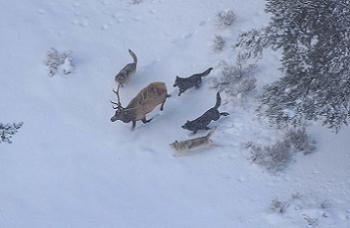 A ‘rider’ attached to the most recent budget passed this week in the US congress has stripped gray wolves from the protection of the Endangered Species Act, a first in the law’s nearly 40-year-history. The rider, which was signed into law under the budget on Friday by US President Barack Obama, hands gray wolves (Canis […]
A ‘rider’ attached to the most recent budget passed this week in the US congress has stripped gray wolves from the protection of the Endangered Species Act, a first in the law’s nearly 40-year-history. The rider, which was signed into law under the budget on Friday by US President Barack Obama, hands gray wolves (Canis […]
Conservationists oppose snow leopard hunt for ‘science’
 Update:Mongolia has announced it will cancel the hunt of 4 snow leopards for scientific research following an outcry from conservationists. Well-known biologist and Vice President of the big cat conservation organization, Panthera, George Schaller said: “Mongolia’s decision to rescind snow leopard hunting permits is the right one for the species and the country. Minister Gansukh […]
Update:Mongolia has announced it will cancel the hunt of 4 snow leopards for scientific research following an outcry from conservationists. Well-known biologist and Vice President of the big cat conservation organization, Panthera, George Schaller said: “Mongolia’s decision to rescind snow leopard hunting permits is the right one for the species and the country. Minister Gansukh […]
New road project to run through Laos’ last tiger habitat
 A new road project in Laos will run through the nation’s only protected area inhabited by breeding tigers, Nam Et Phou Louey National Park, reports the Vientiane Times. With only about two dozen tigers (Panthera tigris) left in the nation, conservationists fear that the road will harm the fragile population, which is known to be […]
A new road project in Laos will run through the nation’s only protected area inhabited by breeding tigers, Nam Et Phou Louey National Park, reports the Vientiane Times. With only about two dozen tigers (Panthera tigris) left in the nation, conservationists fear that the road will harm the fragile population, which is known to be […]
Fearful Symmetry—Man Made, an interview with John Vaillant, author of The Tiger
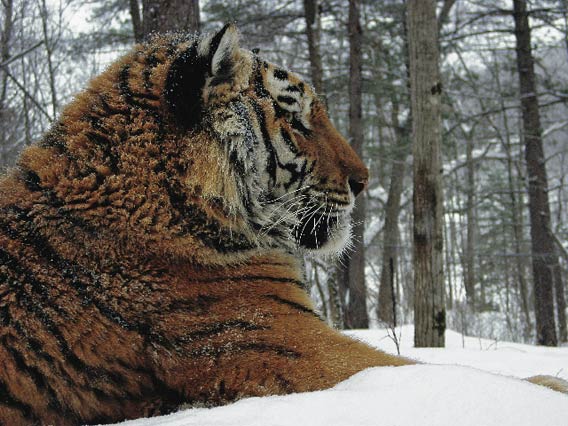 Siberian tiger. John Goodrich (WCS). “Meanwhile, Trush’s dog, Gitta is racing back and forth, hackles raised and barking in alarm. The tiger is somewhere close by—invisible to the men, but to the dog it is palpably, almost unbearably, present. The men, too, can sense a potency around them—something larger than their own fear, and they […]
Siberian tiger. John Goodrich (WCS). “Meanwhile, Trush’s dog, Gitta is racing back and forth, hackles raised and barking in alarm. The tiger is somewhere close by—invisible to the men, but to the dog it is palpably, almost unbearably, present. The men, too, can sense a potency around them—something larger than their own fear, and they […]
Conservation groups propose ban on lion parts in US
 It’s not widely known that the African lion ((Panthera leo) is currently threatened with extinction in the wild, but listed as Vulnerable by the IUCN Red List, the king of animals has declined by over 90% in the past 50 years (from 450,000 lions to between 20,000 and 40,000 today). While conservation work to save […]
It’s not widely known that the African lion ((Panthera leo) is currently threatened with extinction in the wild, but listed as Vulnerable by the IUCN Red List, the king of animals has declined by over 90% in the past 50 years (from 450,000 lions to between 20,000 and 40,000 today). While conservation work to save […]
Parks key to saving India’s great mammals from extinction
 Tigress photo captured at Nagarahole National park by camera trap. Copyright: K Ullas Karanth/WCS. An interview with Krithi Karanth, a part of our Interviews with Young Scientists series. Krithi Karanth grew up amid India’s great mammals—literally. Daughter of conservationist and scientist Dr. Ullas Karanth, she tells mongabay.com that she saw her first wild tigers and […]
Tigress photo captured at Nagarahole National park by camera trap. Copyright: K Ullas Karanth/WCS. An interview with Krithi Karanth, a part of our Interviews with Young Scientists series. Krithi Karanth grew up amid India’s great mammals—literally. Daughter of conservationist and scientist Dr. Ullas Karanth, she tells mongabay.com that she saw her first wild tigers and […]
Saving Madagascar’s largest carnivorous mammal: the fossa
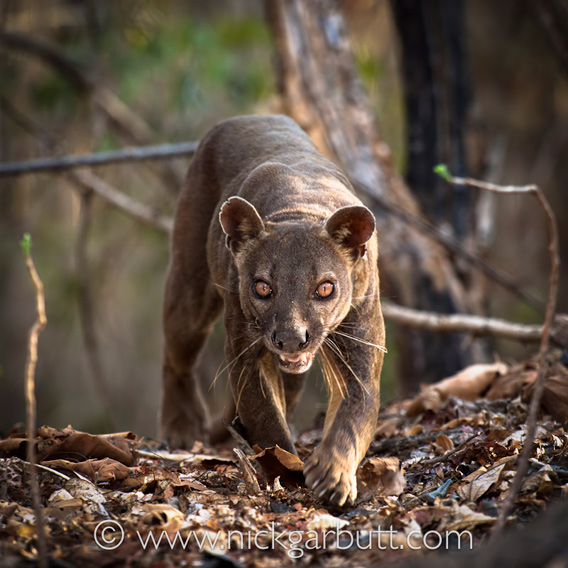 The fossa. Photo © Nick Garbutt . An interview with Mia-Lana Lührs, a part of our Interviews with Young Scientists series. Madagascar is a land of wonders: dancing lemurs, thumbnail-sized chameleons, the long-fingered aye-aye, great baobab trees, and the mighty fossa. Wait—what? What’s a fossa? It’s true that when people think of Madagascar rarely do […]
The fossa. Photo © Nick Garbutt . An interview with Mia-Lana Lührs, a part of our Interviews with Young Scientists series. Madagascar is a land of wonders: dancing lemurs, thumbnail-sized chameleons, the long-fingered aye-aye, great baobab trees, and the mighty fossa. Wait—what? What’s a fossa? It’s true that when people think of Madagascar rarely do […]
Feeds: news | india | latam | brasil | indonesia
 Captive Siberian tiger at the Wildlife Conservation Society’s (WCS) Bronx Zoo. Photo by: Julie Larsen Maher/WCS. The Siberian tiger population continues to rebound, according to the latest numbers from the subspecies’ stronghold in Russia. Ten years ago, conservationists estimated 423-502 Amur tigers in Siberia. But last month, the Russian government and WWF said numbers had […]
Captive Siberian tiger at the Wildlife Conservation Society’s (WCS) Bronx Zoo. Photo by: Julie Larsen Maher/WCS. The Siberian tiger population continues to rebound, according to the latest numbers from the subspecies’ stronghold in Russia. Ten years ago, conservationists estimated 423-502 Amur tigers in Siberia. But last month, the Russian government and WWF said numbers had […]-ZSL_3.jpg ) Tigers have been documented in Thailand’s Chaloem Ratanakosin National Park for the first time. Photo by: ZSL and Thailand’s Department of National Parks. For the first time conservationists have confirmed Indochinese tigers (Panthera tigris corbetti) in Thailand’s Chaloem Ratanakosin National Park. In January, camera traps used by the Zoological Society of London (ZSL) and Thailand’s […]
Tigers have been documented in Thailand’s Chaloem Ratanakosin National Park for the first time. Photo by: ZSL and Thailand’s Department of National Parks. For the first time conservationists have confirmed Indochinese tigers (Panthera tigris corbetti) in Thailand’s Chaloem Ratanakosin National Park. In January, camera traps used by the Zoological Society of London (ZSL) and Thailand’s […] Young lion in Kruger National Park in South Africa. Photo by: Rhett A. Butler. Last month, Australia became the world’s first country to ban the import or export of lion trophies, often taken from so-called canned hunting where lions are raised solely to be shot by foreign hunters. “These new rules mean that if you […]
Young lion in Kruger National Park in South Africa. Photo by: Rhett A. Butler. Last month, Australia became the world’s first country to ban the import or export of lion trophies, often taken from so-called canned hunting where lions are raised solely to be shot by foreign hunters. “These new rules mean that if you […] Male lion in Kruger National Park, South Africa. Most of the world’s lions are now found in southern and eastern Africa. Photo by: Rhett A. Butler. There’s a new cat in town. For the first time since 1996, conservationists have proof of a lion roaming the wilds of the Central African country of Gabon. The […]
Male lion in Kruger National Park, South Africa. Most of the world’s lions are now found in southern and eastern Africa. Photo by: Rhett A. Butler. There’s a new cat in town. For the first time since 1996, conservationists have proof of a lion roaming the wilds of the Central African country of Gabon. The […] An Amur tiger father leading a mother and three cubs in Russia. Photo by: WCS, Sikhote-Alin Biosphere Reserve, and Udegeiskaya Legenda National Park. In a frigid Russian forest, a camera trap snapped 21 family photos over two minutes. This wasn’t a usual family, though, this was a tiger family, more specifically an Amur tiger (Panthera […]
An Amur tiger father leading a mother and three cubs in Russia. Photo by: WCS, Sikhote-Alin Biosphere Reserve, and Udegeiskaya Legenda National Park. In a frigid Russian forest, a camera trap snapped 21 family photos over two minutes. This wasn’t a usual family, though, this was a tiger family, more specifically an Amur tiger (Panthera […] Camera trap of Amur leopard. The Amur leopard evolved its thick coat to keep warm in the cold, long winters. Photo by: WWF. Most of the world’s big predators are in decline, but there are some happy stories out there. This week, WWF announced that the Amur leopard population has grown to a total of […]
Camera trap of Amur leopard. The Amur leopard evolved its thick coat to keep warm in the cold, long winters. Photo by: WWF. Most of the world’s big predators are in decline, but there are some happy stories out there. This week, WWF announced that the Amur leopard population has grown to a total of […] A photo of 914F just north of the Grand Canyon wearing an inactive collar. The wolf was shot dead on in Utah. Photo courtesy of the Arizona Game and Fish Department. Last fall, tourists to the north rim of the Grand Canyon reported seeing a gray wolf (Canis lupus). The only problem was there had […]
A photo of 914F just north of the Grand Canyon wearing an inactive collar. The wolf was shot dead on in Utah. Photo courtesy of the Arizona Game and Fish Department. Last fall, tourists to the north rim of the Grand Canyon reported seeing a gray wolf (Canis lupus). The only problem was there had […] Catching a jaguar on a remote camera trap in the Amazon is a rare, happy sight. But catching a jaguar attempting to ambush a herd of peccaries is quite simply astonishing. “A research assistant, who was coding the videos sent me an email to have a look,” said primatologist, Mark Bowler, a postdoctoral fellow at […]
Catching a jaguar on a remote camera trap in the Amazon is a rare, happy sight. But catching a jaguar attempting to ambush a herd of peccaries is quite simply astonishing. “A research assistant, who was coding the videos sent me an email to have a look,” said primatologist, Mark Bowler, a postdoctoral fellow at […]
 Future wolf hunting and trapping seasons in the Upper Midwest are on hold after a judge ruled the Obama Administration erred in removing the top predator from the Endangered Species Act (ESA) last month. The ruling came nearly three years after the U.S.Fish and Wildlife Service dropped federal protections for the so-called Great Lakes’ wolf […]
Future wolf hunting and trapping seasons in the Upper Midwest are on hold after a judge ruled the Obama Administration erred in removing the top predator from the Endangered Species Act (ESA) last month. The ruling came nearly three years after the U.S.Fish and Wildlife Service dropped federal protections for the so-called Great Lakes’ wolf […] Obama administration proposes to remove wolves from the ESA even as the animals spread to new states A photo of what is believed to be a gray wolf sporting an inactive radio collar in forests just north of the Grand Canyon. Photo courtesy of the Arizona Game and Fish Department. For an update on this […]
Obama administration proposes to remove wolves from the ESA even as the animals spread to new states A photo of what is believed to be a gray wolf sporting an inactive radio collar in forests just north of the Grand Canyon. Photo courtesy of the Arizona Game and Fish Department. For an update on this […].600.jpg) An Antarctic krill. Photo by: Uwe Kils/Creative Commons 3.0. Another year, another failed attempt to protect a significant chunk of the Ross Sea, which sits off the coast of Antarctica. According to observers, efforts to create the world’s biggest marine protected area to date were shot down by Russia and China during a meeting in […]
An Antarctic krill. Photo by: Uwe Kils/Creative Commons 3.0. Another year, another failed attempt to protect a significant chunk of the Ross Sea, which sits off the coast of Antarctica. According to observers, efforts to create the world’s biggest marine protected area to date were shot down by Russia and China during a meeting in […] This photo of slumbering lions has won Michael ‘Nick’ Nichols the much-coveted Wildlife Photographer of the Year Title. Photo by: Michael ‘Nick’ Nichols / Wildlife Photographer of the Year 2014. The king of beasts took this year’s top prize in the Wildlife Photographer of the Year competition, which is co-owned by the Natural History Museum […]
This photo of slumbering lions has won Michael ‘Nick’ Nichols the much-coveted Wildlife Photographer of the Year Title. Photo by: Michael ‘Nick’ Nichols / Wildlife Photographer of the Year 2014. The king of beasts took this year’s top prize in the Wildlife Photographer of the Year competition, which is co-owned by the Natural History Museum […] An interview with Alan Rabinowitz, author of the new book, An Indomitable Beast: the Journey of the Jaguar Female jaguar (staring into camera) with subadult male offspring moving through an old oil palm plantation in the jaguar corridor of Colombia. Photo by: Esteban Payan, Panthera. For thousands of years the jaguar was a God, then […]
An interview with Alan Rabinowitz, author of the new book, An Indomitable Beast: the Journey of the Jaguar Female jaguar (staring into camera) with subadult male offspring moving through an old oil palm plantation in the jaguar corridor of Colombia. Photo by: Esteban Payan, Panthera. For thousands of years the jaguar was a God, then […] On bison, wolves, and woodpeckers: the wonder of Europe’s only lowland virgin forest. Bialowieza Forest at dawn. Old-growth forest is characterized by ancient trees, tall canopies, little undergrowth, and a huge amount of dead wood. Photo by: Lukasz Mazurek/Wild Poland There is almost nothing left of Europe’s famed forests, those that provided for human communities […]
On bison, wolves, and woodpeckers: the wonder of Europe’s only lowland virgin forest. Bialowieza Forest at dawn. Old-growth forest is characterized by ancient trees, tall canopies, little undergrowth, and a huge amount of dead wood. Photo by: Lukasz Mazurek/Wild Poland There is almost nothing left of Europe’s famed forests, those that provided for human communities […] Four donors from around the world have pledged $80 million to cat conservation group, Panthera. The money will fund projects working to preserve tigers, lions, jaguars, cheetahs, leopards, snow leopards, and cougars over ten years. “Today marks a turning point for global cat conservation,” said Panthera Founder and Chairman of the Board, Thomas Kaplan, who […]
Four donors from around the world have pledged $80 million to cat conservation group, Panthera. The money will fund projects working to preserve tigers, lions, jaguars, cheetahs, leopards, snow leopards, and cougars over ten years. “Today marks a turning point for global cat conservation,” said Panthera Founder and Chairman of the Board, Thomas Kaplan, who […] DNA testing has confirmed that an animal shot in February in Iowa’s Buchanan County was in fact a wolf, according to the Iowa Department of Natural Resources. This is the first confirmed gray wolf (Canis lupus) in the U.S. state since 1925. Experts believe the wolf likely traveled south from Wisconsin or Minnesota, the latter […]
DNA testing has confirmed that an animal shot in February in Iowa’s Buchanan County was in fact a wolf, according to the Iowa Department of Natural Resources. This is the first confirmed gray wolf (Canis lupus) in the U.S. state since 1925. Experts believe the wolf likely traveled south from Wisconsin or Minnesota, the latter […] In 1864, Walter Campbell was an officer in the British Army, stationed in India when he penned these words in his journal: “Never attack a tiger on foot—if you can help it. There are cases in which you must do so. Then face him like a Briton, and kill him if you can; for if […]
In 1864, Walter Campbell was an officer in the British Army, stationed in India when he penned these words in his journal: “Never attack a tiger on foot—if you can help it. There are cases in which you must do so. Then face him like a Briton, and kill him if you can; for if […] Lioness feeding. Photo by: Cyril Christo and Marie Wilkinson. In the new book, In Predatory Light: Lions and Tigers and Polar Bears, authors Elizabeth Marshall Thomas, Sy Montgomery, and John Houston, and photographers Cyril Christo and Marie Wilkinson share with us an impassioned and detailed appeal to appreciate three of the world’s biggest predators: lions, […]
Lioness feeding. Photo by: Cyril Christo and Marie Wilkinson. In the new book, In Predatory Light: Lions and Tigers and Polar Bears, authors Elizabeth Marshall Thomas, Sy Montgomery, and John Houston, and photographers Cyril Christo and Marie Wilkinson share with us an impassioned and detailed appeal to appreciate three of the world’s biggest predators: lions, […] Hunters and trappers have killed 2,567 gray wolves in the U.S.’s lower 48 states since 2011, according to recent data. Gray wolves (Canis lupus) were protected by the Endangered Species Act (ESA) for nearly 40 years before being stripped of their protection status by a legislative rider in 2011. Last year total wolf populations were […]
Hunters and trappers have killed 2,567 gray wolves in the U.S.’s lower 48 states since 2011, according to recent data. Gray wolves (Canis lupus) were protected by the Endangered Species Act (ESA) for nearly 40 years before being stripped of their protection status by a legislative rider in 2011. Last year total wolf populations were […] Scientists knew that snow leopards (Panthera uncia) still survived in the Central Asian country of Uzbekistan, but late last year they captured the first ever photos. Camera traps in the Gissar Nature Reserve took photos of the big cats, along with bear, lynx, ibex, wild boar, and other mammals. The camera trap program was led […]
Scientists knew that snow leopards (Panthera uncia) still survived in the Central Asian country of Uzbekistan, but late last year they captured the first ever photos. Camera traps in the Gissar Nature Reserve took photos of the big cats, along with bear, lynx, ibex, wild boar, and other mammals. The camera trap program was led […] The world’s top carnivores are in big trouble: this is the take-away message from a new review paper published today in Science. Looking at 31 large-bodied carnivore species (i.e those over 15 kilograms or 33 pounds), the researchers found that 77 percent are in decline and more than half have seen their historical ranges decline […]
The world’s top carnivores are in big trouble: this is the take-away message from a new review paper published today in Science. Looking at 31 large-bodied carnivore species (i.e those over 15 kilograms or 33 pounds), the researchers found that 77 percent are in decline and more than half have seen their historical ranges decline […] Shivani Bhalla will be speaking at the Wildlife Conservation Network Expo in San Francisco on October 12th, 2013. In 2009 conservationists estimated that less than 2,000 lions survive in Kenya, a drop of 26 percent in just seven years. In addition, the East Africa country continues to hemorrhage lions: around a hundred a year. Poaching, […]
Shivani Bhalla will be speaking at the Wildlife Conservation Network Expo in San Francisco on October 12th, 2013. In 2009 conservationists estimated that less than 2,000 lions survive in Kenya, a drop of 26 percent in just seven years. In addition, the East Africa country continues to hemorrhage lions: around a hundred a year. Poaching, […] Colleen Begg will be speaking at the Wildlife Conservation Network Expo in San Francisco on October 12th, 2013. Everyone knows that tigers, pandas, and blue whales are threatened with extinction—but lions!? Researchers were shocked to recently discover that lion populations have fallen precipitously: down to around 30,000 animals across the African continent. While 30,000 may […]
Colleen Begg will be speaking at the Wildlife Conservation Network Expo in San Francisco on October 12th, 2013. Everyone knows that tigers, pandas, and blue whales are threatened with extinction—but lions!? Researchers were shocked to recently discover that lion populations have fallen precipitously: down to around 30,000 animals across the African continent. While 30,000 may […] A Ruaha male lion in his prime. Photo © : Sasja van Vechgel. The Serengeti, the Congo, the Okavango Delta: many of Africa’s great wildernesses are household names, however on a continent that never fails to surprise remain vast wild lands practically unknown to the global public. One of these is the Ruaha landscape: covering […]
A Ruaha male lion in his prime. Photo © : Sasja van Vechgel. The Serengeti, the Congo, the Okavango Delta: many of Africa’s great wildernesses are household names, however on a continent that never fails to surprise remain vast wild lands practically unknown to the global public. One of these is the Ruaha landscape: covering […] In the video below, John Vaillant, author of the The Tiger: A True Story of Vengeance and Survival, tells an audience at TEDxYYC about the similarities between tigers and human beings. Given these similarities—big mammals, apex predator, highly adaptable, intelligent, and stunningly “superior”—John Vaillant asks an illuminating question: what can we learn from the tiger? […]
In the video below, John Vaillant, author of the The Tiger: A True Story of Vengeance and Survival, tells an audience at TEDxYYC about the similarities between tigers and human beings. Given these similarities—big mammals, apex predator, highly adaptable, intelligent, and stunningly “superior”—John Vaillant asks an illuminating question: what can we learn from the tiger? […] Nearly two hundred tigers roam the lowland forests of Nepal, according to a new survey. This is a 63 percent increase in the country’s tiger population since 2009, and rare good news for global efforts to save the tiger from extinction. The survey counted 198 Bengal tigers (Panthera tigris tigris) across five parks and three […]
Nearly two hundred tigers roam the lowland forests of Nepal, according to a new survey. This is a 63 percent increase in the country’s tiger population since 2009, and rare good news for global efforts to save the tiger from extinction. The survey counted 198 Bengal tigers (Panthera tigris tigris) across five parks and three […] At least 60 big cats have been killed within national protected areas in Brazil during the past two years according to a recent survey published in mongabay.com’s open access journal Tropical Conservation Science (TCS). The report, which focuses on jaguar (Panthera onca) and puma (Puma concolor) populations, within Brazilian protected areas shows that reserve management […]
At least 60 big cats have been killed within national protected areas in Brazil during the past two years according to a recent survey published in mongabay.com’s open access journal Tropical Conservation Science (TCS). The report, which focuses on jaguar (Panthera onca) and puma (Puma concolor) populations, within Brazilian protected areas shows that reserve management […] There are often many obstacles for scientists when gauging wildlife decline and forest loss, and one of the most difficult is civil conflict, like the situation in the Similipal Tiger Reserve in India. But a new study in mongabay.com’s open access journal Tropical Conservation Science (TCS) finds that local communities may be used to gauge […]
There are often many obstacles for scientists when gauging wildlife decline and forest loss, and one of the most difficult is civil conflict, like the situation in the Similipal Tiger Reserve in India. But a new study in mongabay.com’s open access journal Tropical Conservation Science (TCS) finds that local communities may be used to gauge […] What does a wolf in Yellowstone National Park have in common with an ambush spider on a meadow in Connecticut? Both are predators and thus eat herbivores, such as elk (in the case of wolves) and grasshoppers (in the case of spiders). Elk and grasshoppers also have more in common than you probably imagine: they […]
What does a wolf in Yellowstone National Park have in common with an ambush spider on a meadow in Connecticut? Both are predators and thus eat herbivores, such as elk (in the case of wolves) and grasshoppers (in the case of spiders). Elk and grasshoppers also have more in common than you probably imagine: they […] The 2013 Zoos and Aquariums: Committing to Conservation (ZACC) conference runs from July 8th—July 12th in Des Moines, Iowa, hosted by the Blank Park Zoo. Ahead of the event, Mongabay.com is running a series of Q&As with presenters. For more interviews, please see our ZACC feed. Snow leopard. Photo by: Steve Winter/National Geographic. Tibetan monks […]
The 2013 Zoos and Aquariums: Committing to Conservation (ZACC) conference runs from July 8th—July 12th in Des Moines, Iowa, hosted by the Blank Park Zoo. Ahead of the event, Mongabay.com is running a series of Q&As with presenters. For more interviews, please see our ZACC feed. Snow leopard. Photo by: Steve Winter/National Geographic. Tibetan monks […]-WCS-Russia.600.jpg) The 2013 Zoos and Aquariums: Committing to Conservation (ZACC) conference runs from July 8th – July 12th in Des Moines, Iowa, hosted by the Blank Park Zoo. Ahead of the event, Mongabay.com is running a series of Q&As with presenters. For more interviews, please see our ZACC feed. An Amur tiger in the Sikhote-Alin Mountains, […]
The 2013 Zoos and Aquariums: Committing to Conservation (ZACC) conference runs from July 8th – July 12th in Des Moines, Iowa, hosted by the Blank Park Zoo. Ahead of the event, Mongabay.com is running a series of Q&As with presenters. For more interviews, please see our ZACC feed. An Amur tiger in the Sikhote-Alin Mountains, […] Less than a hundred kilometers from the bustling metropolis of Jakarta, scientists have captured incredible photos of one of the world’s most endangered big cats: the Javan leopard (Panthera pardus melas). Taken by a research project in Gunung Halimun-Salak National Park, the photos show the magnificent animal relaxing in dense primary rainforest. Scientists believe that […]
Less than a hundred kilometers from the bustling metropolis of Jakarta, scientists have captured incredible photos of one of the world’s most endangered big cats: the Javan leopard (Panthera pardus melas). Taken by a research project in Gunung Halimun-Salak National Park, the photos show the magnificent animal relaxing in dense primary rainforest. Scientists believe that […] Many people still believe the Tasmanian tiger (Thylacinus cynocephalus) survives in the wilds of Tasmania, even though the species was declared extinct over eighty years ago. Sightings and reports of the elusive carnivorous marsupial, which was the top predator on the island, pop-up almost as frequently as those of Bigfoot in North America, but to […]
Many people still believe the Tasmanian tiger (Thylacinus cynocephalus) survives in the wilds of Tasmania, even though the species was declared extinct over eighty years ago. Sightings and reports of the elusive carnivorous marsupial, which was the top predator on the island, pop-up almost as frequently as those of Bigfoot in North America, but to […] Jaguars (Panthera onca) are the biggest cat in the Americas and the only member of the Panthera genus in the New World; an animal most people recognize, the jaguar is also the third largest cat in the world with an intoxicatingly dangerous beauty. The feline ranges from the harsh deserts of southern Arizona to the […]
Jaguars (Panthera onca) are the biggest cat in the Americas and the only member of the Panthera genus in the New World; an animal most people recognize, the jaguar is also the third largest cat in the world with an intoxicatingly dangerous beauty. The feline ranges from the harsh deserts of southern Arizona to the […] What happens to animals when their forest is cut down? If they can, they migrate to different forests. But in an age when forests are falling far and fast, many species may have to shift to entirely different environments. A new paper in Folia Primatologica theorizes that some 60 primate species and 20 wild cat […]
What happens to animals when their forest is cut down? If they can, they migrate to different forests. But in an age when forests are falling far and fast, many species may have to shift to entirely different environments. A new paper in Folia Primatologica theorizes that some 60 primate species and 20 wild cat […] After 13 years of searching for the Formosan clouded leopard (Neofelis nebulosa brachyura), once hopeful scientists say they believe the cat is likely extinct. For more than a decade scientists set up over 1,500 camera traps and scent traps in the mountains of Taiwan where they believed the cat may still be hiding out, only […]
After 13 years of searching for the Formosan clouded leopard (Neofelis nebulosa brachyura), once hopeful scientists say they believe the cat is likely extinct. For more than a decade scientists set up over 1,500 camera traps and scent traps in the mountains of Taiwan where they believed the cat may still be hiding out, only […] The U.S. Fish and Wildlife Service (USFWS) is proposing to end protection for all gray wolves (Canis lupus) in the lower 48 states, save for a small population of Mexican wolves in New Mexico, reports the Los Angeles Times. The proposal comes two years after wolves were removed from the Endangered Species Act (ESA) in […]
The U.S. Fish and Wildlife Service (USFWS) is proposing to end protection for all gray wolves (Canis lupus) in the lower 48 states, save for a small population of Mexican wolves in New Mexico, reports the Los Angeles Times. The proposal comes two years after wolves were removed from the Endangered Species Act (ESA) in […] Koos Hermanus would rather not give names to the lions he breeds. So here, behind a 2.4-meter high electric fence, is 1R, a three-and-a-half-year-old male, who consumes 5kg of meat a day and weighs almost 200kg. It will only leave its enclosure once it has been “booked”‘ by a hunter, most of whom are from […]
Koos Hermanus would rather not give names to the lions he breeds. So here, behind a 2.4-meter high electric fence, is 1R, a three-and-a-half-year-old male, who consumes 5kg of meat a day and weighs almost 200kg. It will only leave its enclosure once it has been “booked”‘ by a hunter, most of whom are from […] In the remote Russian far east, amid pine forests and long winters, a great cat may be beginning to make a recovery. A new survey estimates that the Amur leopard (Panthera pardus orientalis) population has risen to as many as 50 individuals. While this may not sound like much, it’s a far cry from a […]
In the remote Russian far east, amid pine forests and long winters, a great cat may be beginning to make a recovery. A new survey estimates that the Amur leopard (Panthera pardus orientalis) population has risen to as many as 50 individuals. While this may not sound like much, it’s a far cry from a […] Female lion with wildebeest kill in Tanzania. Photo by: Rhett A. Butler. For a long time male lions were derided as the lazy ones in the pride, depending on females for the bulk of hunting and not pulling their weight. Much of this was based on field observations—female lions hunt cooperatively, often in open savannah, […]
Female lion with wildebeest kill in Tanzania. Photo by: Rhett A. Butler. For a long time male lions were derided as the lazy ones in the pride, depending on females for the bulk of hunting and not pulling their weight. Much of this was based on field observations—female lions hunt cooperatively, often in open savannah, […] Male lion in Zambia. Photo by: Stuart Pimm. African lions (Panthera leo) living outside of protected areas like national parks or reserves also happen to be studied much less than those residing within protected areas, to the detriment of lion conservation initiatives. In response to this trend, a group of researchers surveyed an understudied, unprotected […]
Male lion in Zambia. Photo by: Stuart Pimm. African lions (Panthera leo) living outside of protected areas like national parks or reserves also happen to be studied much less than those residing within protected areas, to the detriment of lion conservation initiatives. In response to this trend, a group of researchers surveyed an understudied, unprotected […] Lions hang out by a fence in Tswalu Kalahari Reserve, South Africa. Photo by: Luke Hunter. In order for dwindling lion populations to survive in Africa, large-scale fencing projects may be required according to new research in Ecology Letters. Recent estimates have put lion populations down to 15,000-35,000, a massive drop from a population that […]
Lions hang out by a fence in Tswalu Kalahari Reserve, South Africa. Photo by: Luke Hunter. In order for dwindling lion populations to survive in Africa, large-scale fencing projects may be required according to new research in Ecology Letters. Recent estimates have put lion populations down to 15,000-35,000, a massive drop from a population that […] Tiger bodies in freezer in Guilin Tiger Bear Farm. Photo by: Belinda Wright/WPSI. The number of tigers being captive bred in China for consumption exceed those surviving in the wild—across 13 countries—by over a third, according to a new report by the Environmental Investigation Agency (EIA). The report, Hidden in Plain Sight, alleges that while […]
Tiger bodies in freezer in Guilin Tiger Bear Farm. Photo by: Belinda Wright/WPSI. The number of tigers being captive bred in China for consumption exceed those surviving in the wild—across 13 countries—by over a third, according to a new report by the Environmental Investigation Agency (EIA). The report, Hidden in Plain Sight, alleges that while […].360.jpg) Watching a new video by Amazon explorer, Paul Rosolie, one feels transported into a hidden world of stalking jaguars, heavyweight tapirs, and daylight-wandering giant armadillos. This is the Amazon as one imagines it as a child: still full of wild things. In just four weeks at a single colpa (or clay lick where mammals and […]
Watching a new video by Amazon explorer, Paul Rosolie, one feels transported into a hidden world of stalking jaguars, heavyweight tapirs, and daylight-wandering giant armadillos. This is the Amazon as one imagines it as a child: still full of wild things. In just four weeks at a single colpa (or clay lick where mammals and […] A poster-child for rare species: the Javan rhino (Rhinoceros sondaicus) captured on camera trap in its last stand: Ujung Kulon National Park Java, Indonesia. Photo by: © Mike Griffiths / WWF-Canon. In his new book, The Kingdom of Rarities, Eric Dinerstein chases after rare animals around the world, from the maned wolf (Chrysocyon brachyurus) in […]
A poster-child for rare species: the Javan rhino (Rhinoceros sondaicus) captured on camera trap in its last stand: Ujung Kulon National Park Java, Indonesia. Photo by: © Mike Griffiths / WWF-Canon. In his new book, The Kingdom of Rarities, Eric Dinerstein chases after rare animals around the world, from the maned wolf (Chrysocyon brachyurus) in […] Bengal tiger in Rantgambhore National Park. Photo by: Bjørn Christian Tørrissen. Nearly half of India’s wildlife budget goes to one species: the tiger, reports a recent article in Live Mint. India has devoted around $63 million to wildlife conservation for 2013-2013, of which Project Tiger receives $31 million. The Bengal tiger (Panthera tigris tigris) is […]
Bengal tiger in Rantgambhore National Park. Photo by: Bjørn Christian Tørrissen. Nearly half of India’s wildlife budget goes to one species: the tiger, reports a recent article in Live Mint. India has devoted around $63 million to wildlife conservation for 2013-2013, of which Project Tiger receives $31 million. The Bengal tiger (Panthera tigris tigris) is […] An eighteenth-month-old Amur tiger, named Botzman, was recently moved from a zoo in Moscow to Zoological Society of London (ZSL) Whipsnade Zoo. Photo courtesy of ZSL Whipsnade Zoo. The Amur tiger (Panthera tigris altaica), also known as the Siberian tiger, is the world’s biggest cat. An adult male weighs on average about 390 pounds (176 […]
An eighteenth-month-old Amur tiger, named Botzman, was recently moved from a zoo in Moscow to Zoological Society of London (ZSL) Whipsnade Zoo. Photo courtesy of ZSL Whipsnade Zoo. The Amur tiger (Panthera tigris altaica), also known as the Siberian tiger, is the world’s biggest cat. An adult male weighs on average about 390 pounds (176 […] Wolf in Yellowstone National Park. Photo courtesy of Yellowstone National Park. Hunters and trappers have killed approximately 1,530 wolves over the last 18 months in the contiguous U.S., which excludes Alaska. After being protected under the Endangered Species Act (ESA) for 38 years, gray wolves (Canis lupus) were stripped of their protected states in 2011 […]
Wolf in Yellowstone National Park. Photo courtesy of Yellowstone National Park. Hunters and trappers have killed approximately 1,530 wolves over the last 18 months in the contiguous U.S., which excludes Alaska. After being protected under the Endangered Species Act (ESA) for 38 years, gray wolves (Canis lupus) were stripped of their protected states in 2011 […] Behind bars and waiting for science: the power of genetic testing for the Addis Fifteen. Male and female Addis lions in the Addis Ababa Lion Zoo. Photo courtesy of: Klaus Eulenberger. They languished behind bars in squalid conditions, their very survival in jeopardy. Outside, an international team of advocates strove to bring worldwide attention to […]
Behind bars and waiting for science: the power of genetic testing for the Addis Fifteen. Male and female Addis lions in the Addis Ababa Lion Zoo. Photo courtesy of: Klaus Eulenberger. They languished behind bars in squalid conditions, their very survival in jeopardy. Outside, an international team of advocates strove to bring worldwide attention to […] The tiger is a globally endangered top predator occupying only 7% of its historic range and only 3000-3500 individuals are believed to be left in wild. Picture © Kalyan Varma. Nepal’s Chitwan National Park was the site of a study, published in September 2012 by Carter and others, which concluded that, tigers coexist with humans […]
The tiger is a globally endangered top predator occupying only 7% of its historic range and only 3000-3500 individuals are believed to be left in wild. Picture © Kalyan Varma. Nepal’s Chitwan National Park was the site of a study, published in September 2012 by Carter and others, which concluded that, tigers coexist with humans […] Bengal tiger in Kanha Tiger Reserve. Photo by: Kalyan Varma. During an average year, 87% of households surrounding Kanha Tiger Reserve in Central India report experiencing some kind of conflict with wild animals, according to a new paper in the open-access journal PLOS One. Co-existence with protected, free-roaming wildlife can be a challenge when living […]
Bengal tiger in Kanha Tiger Reserve. Photo by: Kalyan Varma. During an average year, 87% of households surrounding Kanha Tiger Reserve in Central India report experiencing some kind of conflict with wild animals, according to a new paper in the open-access journal PLOS One. Co-existence with protected, free-roaming wildlife can be a challenge when living […] African savannah elephants on the Chobe River in Botswana. From 2014 on, hunting will no longer be allowed in Botswana’s public lands. Photo by: Tiffany Roufs. Three developing countries have recently toughened hunting regulations believing the changes will better protect vanishing species. Botswana has announced it will ban trophy hunting on public lands beginning in […]
African savannah elephants on the Chobe River in Botswana. From 2014 on, hunting will no longer be allowed in Botswana’s public lands. Photo by: Tiffany Roufs. Three developing countries have recently toughened hunting regulations believing the changes will better protect vanishing species. Botswana has announced it will ban trophy hunting on public lands beginning in […] Snow leopard in the Toronto Zoo. Photo by: John Vetterli. The trading of big cat pelts is nothing new, but recent demand for snow leopard pelts and taxidermy mounts has added a new commodity to the illegal trade in wildlife products, according to the Environmental Investigation Agency (EIA). Traditionally, the market for large cat products […]
Snow leopard in the Toronto Zoo. Photo by: John Vetterli. The trading of big cat pelts is nothing new, but recent demand for snow leopard pelts and taxidermy mounts has added a new commodity to the illegal trade in wildlife products, according to the Environmental Investigation Agency (EIA). Traditionally, the market for large cat products […] Female lion with wildebeest kill in Tanzania. Photo by: Rhett A. Butler. African lions, one of the most iconic species on the planet, are in rapid decline. According to a new study in Biodiversity Conservation, the African lion (Panthera leo leo) population has dropped from around 100,000 animals just fifty years ago to as few […]
Female lion with wildebeest kill in Tanzania. Photo by: Rhett A. Butler. African lions, one of the most iconic species on the planet, are in rapid decline. According to a new study in Biodiversity Conservation, the African lion (Panthera leo leo) population has dropped from around 100,000 animals just fifty years ago to as few […] Grasslands in Kenya’s Masai Mara. Photo by: Rhett A. Butler. Few of the world’s ecosystems are more iconic than Africa’s sprawling savannahs home to elephants, giraffes, rhinos, and the undisputed king of the animal kingdom: lions. This wild realm, where megafauna still roam in abundance, has inspired everyone from Ernest Hemingway to Karen Blixen, and […]
Grasslands in Kenya’s Masai Mara. Photo by: Rhett A. Butler. Few of the world’s ecosystems are more iconic than Africa’s sprawling savannahs home to elephants, giraffes, rhinos, and the undisputed king of the animal kingdom: lions. This wild realm, where megafauna still roam in abundance, has inspired everyone from Ernest Hemingway to Karen Blixen, and […] Gaysay Grasslands in Bale Mountains National Park. Photo courtesy of the Frankfurt Zoological Society (FZS). There is a place in the world where wolves live almost entirely off mountain rodents, lions dwell in forests, and freshwater rolls downstream to 12 million people, but the place—Ethiopia’s Bale Mountains National Park—remains imperiled by a lack of legal […]
Gaysay Grasslands in Bale Mountains National Park. Photo courtesy of the Frankfurt Zoological Society (FZS). There is a place in the world where wolves live almost entirely off mountain rodents, lions dwell in forests, and freshwater rolls downstream to 12 million people, but the place—Ethiopia’s Bale Mountains National Park—remains imperiled by a lack of legal […] Many top predators worldwide remain hated and feared. Photo courtesy of the National Park Service. The hugely controversial wolf hunt in the U.S. has spread from the western U.S. (Montana, Idaho, and Wyoming) to the Midwest (Minnesota and Wisconsin) this year. Although the wolf hunt is less than a month old in the region—and only […]
Many top predators worldwide remain hated and feared. Photo courtesy of the National Park Service. The hugely controversial wolf hunt in the U.S. has spread from the western U.S. (Montana, Idaho, and Wyoming) to the Midwest (Minnesota and Wisconsin) this year. Although the wolf hunt is less than a month old in the region—and only […] Lion with a snare around its neck. Photo by: Frederike Otten. Courtesy of Panthera. Bushmeat hunting has become a grave concern for species in West and Central Africa, but a new report notes that lesser-known illegal hunting in Africa’s iconic savannas is also decimating some animals. Surprisingly, illegal hunting across eastern and southern Africa is […]
Lion with a snare around its neck. Photo by: Frederike Otten. Courtesy of Panthera. Bushmeat hunting has become a grave concern for species in West and Central Africa, but a new report notes that lesser-known illegal hunting in Africa’s iconic savannas is also decimating some animals. Surprisingly, illegal hunting across eastern and southern Africa is […] A maned lioness in Botswanna’s Okavango Delta. Photo by: Deon de Villers. The title is not a typo. Sometimes lioness grow manes as rich and large as males, and there appears to be larger proportion of such ‘maned lionesses’ in Botswana’s Okavango Delta. Luke Hunter, head of the cat NGO Panthera, told National Geographic News […]
A maned lioness in Botswanna’s Okavango Delta. Photo by: Deon de Villers. The title is not a typo. Sometimes lioness grow manes as rich and large as males, and there appears to be larger proportion of such ‘maned lionesses’ in Botswana’s Okavango Delta. Luke Hunter, head of the cat NGO Panthera, told National Geographic News […] First camera trap photo of a jaguar taken by Panthera in a deforested area of Costa Rica’s Barbilla-Destierro SubCorridor. Photo by: Panthera. Jaguar conservation has received a huge boost in the past few months both in Latin America and in the U.S. An historic agreement singed between the world’s leading wild cat conservation organization Panthera […]
First camera trap photo of a jaguar taken by Panthera in a deforested area of Costa Rica’s Barbilla-Destierro SubCorridor. Photo by: Panthera. Jaguar conservation has received a huge boost in the past few months both in Latin America and in the U.S. An historic agreement singed between the world’s leading wild cat conservation organization Panthera […] The Siberian tiger triplets were born to parents, Katharina and Sasha. Photo by: Julie Larsen Maher/WCS. Last month, the Wildlife Conservation Society’s (WCS) Bronx Zoo saw the arrival of three Siberian tiger cubs (Panthera tigris altaica). Also known as Amur tigers, they are the world’s largest cats with adult males weighing up to 318 kilograms […]
The Siberian tiger triplets were born to parents, Katharina and Sasha. Photo by: Julie Larsen Maher/WCS. Last month, the Wildlife Conservation Society’s (WCS) Bronx Zoo saw the arrival of three Siberian tiger cubs (Panthera tigris altaica). Also known as Amur tigers, they are the world’s largest cats with adult males weighing up to 318 kilograms […] Maned wolf at Beardsley Zoo. Photo by: Sage Ross. Known for its abnormally long lanky legs, its reddish-orange coat, and its omnivorous diet, the maned wolf (Chrysocyon brachyurus) is one of the more beautiful and bizarre predators of South America. However its stronghold, the Brazilian Cerrado, is vanishing rapidly to industrialized agriculture and urban development. […]
Maned wolf at Beardsley Zoo. Photo by: Sage Ross. Known for its abnormally long lanky legs, its reddish-orange coat, and its omnivorous diet, the maned wolf (Chrysocyon brachyurus) is one of the more beautiful and bizarre predators of South America. However its stronghold, the Brazilian Cerrado, is vanishing rapidly to industrialized agriculture and urban development. […] Female lion peers through the thick foliage of a montane rainforest in Ethiopia. Photo by: Bruno D’Amicis/NABU. Calling the African lion (Panthera leo) the ‘king of the jungle’ is usually a misnomer, as the species is almost always found in savannah or dry forests, but recent photos by the Germany-based Nature and Biodiversity Conservation Union […]
Female lion peers through the thick foliage of a montane rainforest in Ethiopia. Photo by: Bruno D’Amicis/NABU. Calling the African lion (Panthera leo) the ‘king of the jungle’ is usually a misnomer, as the species is almost always found in savannah or dry forests, but recent photos by the Germany-based Nature and Biodiversity Conservation Union […] The research team conducts a dental exam of a snow leopard prior to its release. Photo by: Anthony Simms/WCS. Scientists have captured and collared two snow leopards (Panthera uncia), arguably one of the world’s most elusive predators, in Afghanistan for the first time. Undertaken by researchers with Wildlife Conservation Society (WCS) and Afghani vets, the […]
The research team conducts a dental exam of a snow leopard prior to its release. Photo by: Anthony Simms/WCS. Scientists have captured and collared two snow leopards (Panthera uncia), arguably one of the world’s most elusive predators, in Afghanistan for the first time. Undertaken by researchers with Wildlife Conservation Society (WCS) and Afghani vets, the […] Bengal tiger in Rantgambhore National Park. Photo by: Bjørn Christian Tørrissen. Since January 1st, 48 Bengal tigers (Panthera tigris tigris) have been found dead in India, which has the world’s largest population of tigers. According to India’s National Tiger Conservation Authority (NTCA), 19 of those deaths have been confirmed to be at the hands of […]
Bengal tiger in Rantgambhore National Park. Photo by: Bjørn Christian Tørrissen. Since January 1st, 48 Bengal tigers (Panthera tigris tigris) have been found dead in India, which has the world’s largest population of tigers. According to India’s National Tiger Conservation Authority (NTCA), 19 of those deaths have been confirmed to be at the hands of […] This six-month old Sumatran tiger cub was strung up in a snare for three days before it was rescued. However, it’s paw had to be amputated. While the cub survived, its freedom has been lost. Unable to hunt and fend for itself, the cub now lives in captivity on the Indonesian island of Java. Photo […]
This six-month old Sumatran tiger cub was strung up in a snare for three days before it was rescued. However, it’s paw had to be amputated. While the cub survived, its freedom has been lost. Unable to hunt and fend for itself, the cub now lives in captivity on the Indonesian island of Java. Photo […] A year-and-a-half after a landmark summit that pledged to double the world’s number of tigers by 2022, and still 65 percent of tiger reserves lack minimum standards of protection for the world’s largest cat, according to the World Wide Fund for Nature (WWF). Reporting at the first meeting of all 13 tiger-range countries since the […]
A year-and-a-half after a landmark summit that pledged to double the world’s number of tigers by 2022, and still 65 percent of tiger reserves lack minimum standards of protection for the world’s largest cat, according to the World Wide Fund for Nature (WWF). Reporting at the first meeting of all 13 tiger-range countries since the […] A Javan tiger in 1938 at Ujung Kulon. Photo by: Andries Hoogerwerf. Although officially declared extinct in 2003, some people believe the Javan tiger (panthera tigris sondaica) is still alive in the island’s Meru Betiri National Park. To prove the big cat has not vanished for good, wildlife officials have installed five camera traps in […]
A Javan tiger in 1938 at Ujung Kulon. Photo by: Andries Hoogerwerf. Although officially declared extinct in 2003, some people believe the Javan tiger (panthera tigris sondaica) is still alive in the island’s Meru Betiri National Park. To prove the big cat has not vanished for good, wildlife officials have installed five camera traps in […] Sumatra rainforest canopy seen from the base of a compass tree . Photo by: Rhett A. Butler. UPDATE: Greenpeace has stated that it has handed over evidence of illegal logging by APP suppliers to Indonesian police; an investigation looks likely. A year-long undercover investigation has found evidence of Asia Pulp and Paper (APP) companies cutting […]
Sumatra rainforest canopy seen from the base of a compass tree . Photo by: Rhett A. Butler. UPDATE: Greenpeace has stated that it has handed over evidence of illegal logging by APP suppliers to Indonesian police; an investigation looks likely. A year-long undercover investigation has found evidence of Asia Pulp and Paper (APP) companies cutting […] Wolf in Yellowstone National Park. Photo courtesy of Yellowstone National Park. Less than a year after being pulled off the Endangered Species Act (ESA), gray wolves (Canis lupus) in the western U.S. are facing an onslaught of hunting. The hunting season for wolves has just closed in Montana with 160 individuals killed, around 75 percent […]
Wolf in Yellowstone National Park. Photo courtesy of Yellowstone National Park. Less than a year after being pulled off the Endangered Species Act (ESA), gray wolves (Canis lupus) in the western U.S. are facing an onslaught of hunting. The hunting season for wolves has just closed in Montana with 160 individuals killed, around 75 percent […] Coyote feeding on elk carcass in Yellowstone National Park. Photo by: Jim Peaco/U.S. National Park Service. Not long ago, geologically speaking, coyotes (Canis latrans) were bigger and more robust than today’s animals. In the late Pleistocene, over 10,000 years ago, coyotes rivaled grey wolves (Canis lupus) in size. But, according to a new paper in […]
Coyote feeding on elk carcass in Yellowstone National Park. Photo by: Jim Peaco/U.S. National Park Service. Not long ago, geologically speaking, coyotes (Canis latrans) were bigger and more robust than today’s animals. In the late Pleistocene, over 10,000 years ago, coyotes rivaled grey wolves (Canis lupus) in size. But, according to a new paper in […] This article is available for a limited time on mongabay.com. It has also been published in a book by mongabay journalist, Jeremy Hance: Life is Good: Conservation in an Age of Mass Extinction. The book is also available in Europe. This is an expanded version of an article that ran on Yale e360 on December […]
This article is available for a limited time on mongabay.com. It has also been published in a book by mongabay journalist, Jeremy Hance: Life is Good: Conservation in an Age of Mass Extinction. The book is also available in Europe. This is an expanded version of an article that ran on Yale e360 on December […] An American alligator and a Burmese python struggle in Everglades National Park. Photo by: Lori Oberhofer, U.S. National Park Service. The Everglades in southern Florida has faced myriad environmental impacts from draining for sprawl to the construction of canals, but even as the U.S. government moves slowly on an ambitious plan to restore the massive […]
An American alligator and a Burmese python struggle in Everglades National Park. Photo by: Lori Oberhofer, U.S. National Park Service. The Everglades in southern Florida has faced myriad environmental impacts from draining for sprawl to the construction of canals, but even as the U.S. government moves slowly on an ambitious plan to restore the massive […] A 593 pound Pacific bluefin tuna sold for $735,000 (56.49 million yen) in Tokyo’s Tsukiji market today. This beats the previous record price hit last year by over $260,000. Why so expensive? Bluefin tuna, considered the best sashimi and sushi in the world, have been fished to near extinction with the population of the Pacific […]
A 593 pound Pacific bluefin tuna sold for $735,000 (56.49 million yen) in Tokyo’s Tsukiji market today. This beats the previous record price hit last year by over $260,000. Why so expensive? Bluefin tuna, considered the best sashimi and sushi in the world, have been fished to near extinction with the population of the Pacific […] Scorched rainforest in Sumatra. Photo by: Steve Winter/National Geographic. The first-ever Sumatran-wide survey of the island’s top predator, the Sumatran tiger (Panthera tigris sumatrae), proves that the great cat is holding on even as forests continue to vanish. The study, carried out by eight NGOs and the Indonesian government, shows that the tiger is still […]
Scorched rainforest in Sumatra. Photo by: Steve Winter/National Geographic. The first-ever Sumatran-wide survey of the island’s top predator, the Sumatran tiger (Panthera tigris sumatrae), proves that the great cat is holding on even as forests continue to vanish. The study, carried out by eight NGOs and the Indonesian government, shows that the tiger is still […] Singa betina mempertahankan wildebeest yang terbunuh di Tanzania. Foto oleh: Rhett A. Butler. Populasi serigala di seluruh dunia telah turun sekitar 99 persen dari jumlah populasi yang pernah ada dalam sejarah. Populasi singa jatuh dari 450.000 menjadi 20.000 dalam 50 tahun. Tiga subspesies harimau punah di abad ke-20. Penangkapan ikan yang berlebihan dan pemotongan sirip […]
Singa betina mempertahankan wildebeest yang terbunuh di Tanzania. Foto oleh: Rhett A. Butler. Populasi serigala di seluruh dunia telah turun sekitar 99 persen dari jumlah populasi yang pernah ada dalam sejarah. Populasi singa jatuh dari 450.000 menjadi 20.000 dalam 50 tahun. Tiga subspesies harimau punah di abad ke-20. Penangkapan ikan yang berlebihan dan pemotongan sirip […] Nile crocodile in Madagascar. Photo by: Rhett A. Butler. DNA has shown that the Nile crocodile is in fact two very different species: a bigger, more aggressive crocodile and a smaller, tamer species that today survives only in West Africa. While the taxonomy of the Nile crocodile has been controversial for over a century, the […]
Nile crocodile in Madagascar. Photo by: Rhett A. Butler. DNA has shown that the Nile crocodile is in fact two very different species: a bigger, more aggressive crocodile and a smaller, tamer species that today survives only in West Africa. While the taxonomy of the Nile crocodile has been controversial for over a century, the […] In 2000 the Canada lynx (Lynx canadensis) was listed as threatened under the US Endangered Species Act (ESA). While remaining stable in Canada and Alaska, the Canada lynx population had essentially collapsed in much of the continental US, excluding Alaska. Aside from habitat loss, one of the main factors imperiling the medium-sized wild cat was […]
In 2000 the Canada lynx (Lynx canadensis) was listed as threatened under the US Endangered Species Act (ESA). While remaining stable in Canada and Alaska, the Canada lynx population had essentially collapsed in much of the continental US, excluding Alaska. Aside from habitat loss, one of the main factors imperiling the medium-sized wild cat was […] WARNING: Graphic photos after the article. Leopard caught on camera trap in Gabon. Photo by: Philipp Henschel/Panthera. According to a surprising new study in the Journal of Zoology, bushmeat hunting is imperiling jungle-dwelling leopards (Panthera pardus) in Africa, even though hunters aren’t targeting the elusive big cats themselves. Instead, by hunting many of the leopard’s […]
WARNING: Graphic photos after the article. Leopard caught on camera trap in Gabon. Photo by: Philipp Henschel/Panthera. According to a surprising new study in the Journal of Zoology, bushmeat hunting is imperiling jungle-dwelling leopards (Panthera pardus) in Africa, even though hunters aren’t targeting the elusive big cats themselves. Instead, by hunting many of the leopard’s […] Central Suriname Nature Reserve, Suriname. A jaguar (Panthera Onca), a Near Threatened species. Of the sites researched, Suriname’s site presented the highest number of species diversity. Photo courtesy of Conservation International Suriname, a member of the TEAM network. A groundbreaking cameratrap study has mapped the abundance, or lack thereof, of tropical mammal populations across seven […]
Central Suriname Nature Reserve, Suriname. A jaguar (Panthera Onca), a Near Threatened species. Of the sites researched, Suriname’s site presented the highest number of species diversity. Photo courtesy of Conservation International Suriname, a member of the TEAM network. A groundbreaking cameratrap study has mapped the abundance, or lack thereof, of tropical mammal populations across seven […] Lioness defends wildebeest kill in Tanzania. Photo by: Rhett A. Butler. Worldwide wolf populations have dropped around 99 percent from historic populations. Lion populations have fallen from 450,000 to 20,000 in 50 years. Three subspecies of tiger went extinct in the 20th Century. Overfishing and finning has cut some shark populations down by 90 percent […]
Lioness defends wildebeest kill in Tanzania. Photo by: Rhett A. Butler. Worldwide wolf populations have dropped around 99 percent from historic populations. Lion populations have fallen from 450,000 to 20,000 in 50 years. Three subspecies of tiger went extinct in the 20th Century. Overfishing and finning has cut some shark populations down by 90 percent […].568.jpg) Snow leopard in the Wakhan Corridor caught on camera trap. Photo by: Wildlife Conservation Society. Decades of war and poverty has not exterminated snow leopards (Panthera uncia) in Afghanistan according to a new paper in the International Journal of Environmental Studies, written by researchers with the Wildlife Conservation Society (WCS). Instead the researchers report a […]
Snow leopard in the Wakhan Corridor caught on camera trap. Photo by: Wildlife Conservation Society. Decades of war and poverty has not exterminated snow leopards (Panthera uncia) in Afghanistan according to a new paper in the International Journal of Environmental Studies, written by researchers with the Wildlife Conservation Society (WCS). Instead the researchers report a […] Polar bear beside a whale carcass. Taken with a remote camera. © National Geographic Entertainment. Photo by: Florian Schulz. Although scientists say innumerable species are threatened by climate change, polar bears have been the global symbol of the movement to rein-in greenhouse gas emissions. This is perhaps not surprising, since polar bears are well known […]
Polar bear beside a whale carcass. Taken with a remote camera. © National Geographic Entertainment. Photo by: Florian Schulz. Although scientists say innumerable species are threatened by climate change, polar bears have been the global symbol of the movement to rein-in greenhouse gas emissions. This is perhaps not surprising, since polar bears are well known […] Grazing halos are clearly seen surrounding coral patch reefs in the Red Sea. Image downloaded from Google Earth Pro 7 June 2011. Image date 19 Dec. 2010. Image copyright 2011 GeoEye. From the all-seeing eye of Google Earth, one can spy the tip of Mount Everest, traffic on 5th Avenue in Manhattan, and the ruins […]
Grazing halos are clearly seen surrounding coral patch reefs in the Red Sea. Image downloaded from Google Earth Pro 7 June 2011. Image date 19 Dec. 2010. Image copyright 2011 GeoEye. From the all-seeing eye of Google Earth, one can spy the tip of Mount Everest, traffic on 5th Avenue in Manhattan, and the ruins […] A ‘rider’ attached to the most recent budget passed this week in the US congress has stripped gray wolves from the protection of the Endangered Species Act, a first in the law’s nearly 40-year-history. The rider, which was signed into law under the budget on Friday by US President Barack Obama, hands gray wolves (Canis […]
A ‘rider’ attached to the most recent budget passed this week in the US congress has stripped gray wolves from the protection of the Endangered Species Act, a first in the law’s nearly 40-year-history. The rider, which was signed into law under the budget on Friday by US President Barack Obama, hands gray wolves (Canis […] Update:Mongolia has announced it will cancel the hunt of 4 snow leopards for scientific research following an outcry from conservationists. Well-known biologist and Vice President of the big cat conservation organization, Panthera, George Schaller said: “Mongolia’s decision to rescind snow leopard hunting permits is the right one for the species and the country. Minister Gansukh […]
Update:Mongolia has announced it will cancel the hunt of 4 snow leopards for scientific research following an outcry from conservationists. Well-known biologist and Vice President of the big cat conservation organization, Panthera, George Schaller said: “Mongolia’s decision to rescind snow leopard hunting permits is the right one for the species and the country. Minister Gansukh […] A new road project in Laos will run through the nation’s only protected area inhabited by breeding tigers, Nam Et Phou Louey National Park, reports the Vientiane Times. With only about two dozen tigers (Panthera tigris) left in the nation, conservationists fear that the road will harm the fragile population, which is known to be […]
A new road project in Laos will run through the nation’s only protected area inhabited by breeding tigers, Nam Et Phou Louey National Park, reports the Vientiane Times. With only about two dozen tigers (Panthera tigris) left in the nation, conservationists fear that the road will harm the fragile population, which is known to be […] Siberian tiger. John Goodrich (WCS). “Meanwhile, Trush’s dog, Gitta is racing back and forth, hackles raised and barking in alarm. The tiger is somewhere close by—invisible to the men, but to the dog it is palpably, almost unbearably, present. The men, too, can sense a potency around them—something larger than their own fear, and they […]
Siberian tiger. John Goodrich (WCS). “Meanwhile, Trush’s dog, Gitta is racing back and forth, hackles raised and barking in alarm. The tiger is somewhere close by—invisible to the men, but to the dog it is palpably, almost unbearably, present. The men, too, can sense a potency around them—something larger than their own fear, and they […] It’s not widely known that the African lion ((Panthera leo) is currently threatened with extinction in the wild, but listed as Vulnerable by the IUCN Red List, the king of animals has declined by over 90% in the past 50 years (from 450,000 lions to between 20,000 and 40,000 today). While conservation work to save […]
It’s not widely known that the African lion ((Panthera leo) is currently threatened with extinction in the wild, but listed as Vulnerable by the IUCN Red List, the king of animals has declined by over 90% in the past 50 years (from 450,000 lions to between 20,000 and 40,000 today). While conservation work to save […] Tigress photo captured at Nagarahole National park by camera trap. Copyright: K Ullas Karanth/WCS. An interview with Krithi Karanth, a part of our Interviews with Young Scientists series. Krithi Karanth grew up amid India’s great mammals—literally. Daughter of conservationist and scientist Dr. Ullas Karanth, she tells mongabay.com that she saw her first wild tigers and […]
Tigress photo captured at Nagarahole National park by camera trap. Copyright: K Ullas Karanth/WCS. An interview with Krithi Karanth, a part of our Interviews with Young Scientists series. Krithi Karanth grew up amid India’s great mammals—literally. Daughter of conservationist and scientist Dr. Ullas Karanth, she tells mongabay.com that she saw her first wild tigers and […] The fossa. Photo © Nick Garbutt . An interview with Mia-Lana Lührs, a part of our Interviews with Young Scientists series. Madagascar is a land of wonders: dancing lemurs, thumbnail-sized chameleons, the long-fingered aye-aye, great baobab trees, and the mighty fossa. Wait—what? What’s a fossa? It’s true that when people think of Madagascar rarely do […]
The fossa. Photo © Nick Garbutt . An interview with Mia-Lana Lührs, a part of our Interviews with Young Scientists series. Madagascar is a land of wonders: dancing lemurs, thumbnail-sized chameleons, the long-fingered aye-aye, great baobab trees, and the mighty fossa. Wait—what? What’s a fossa? It’s true that when people think of Madagascar rarely do […]